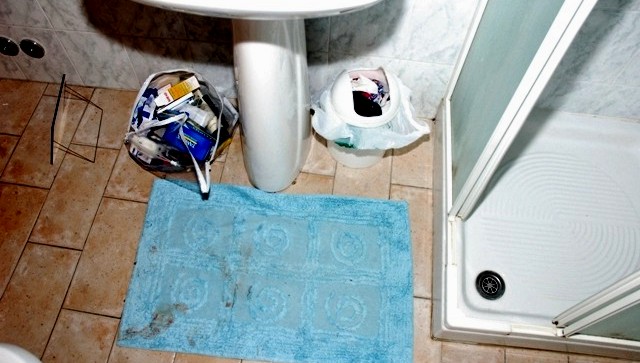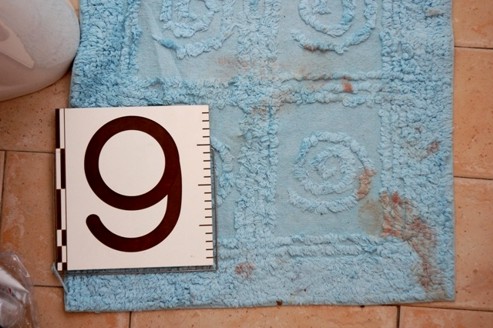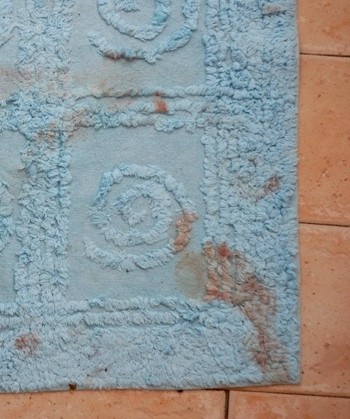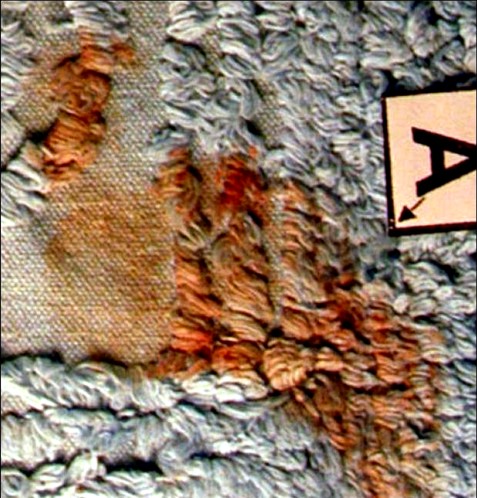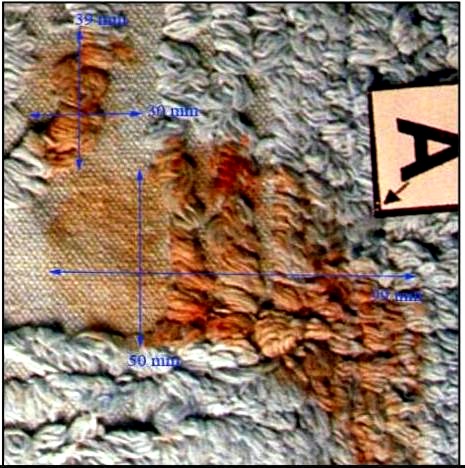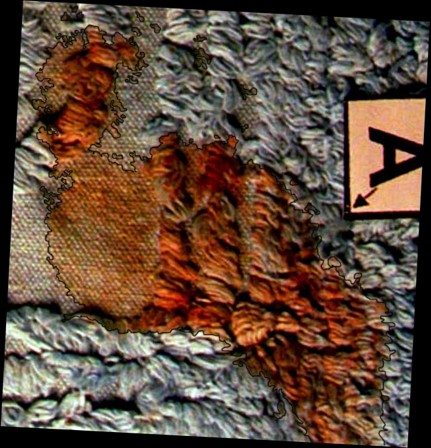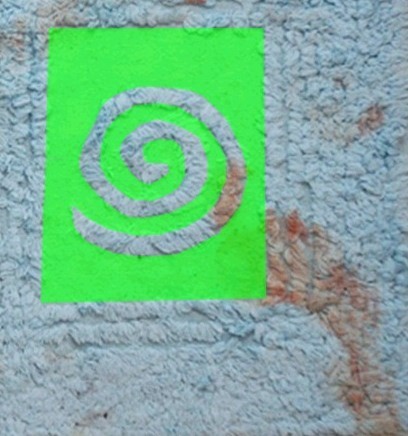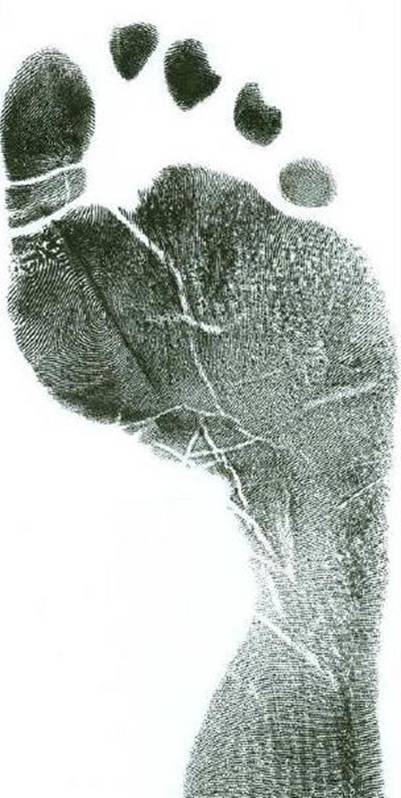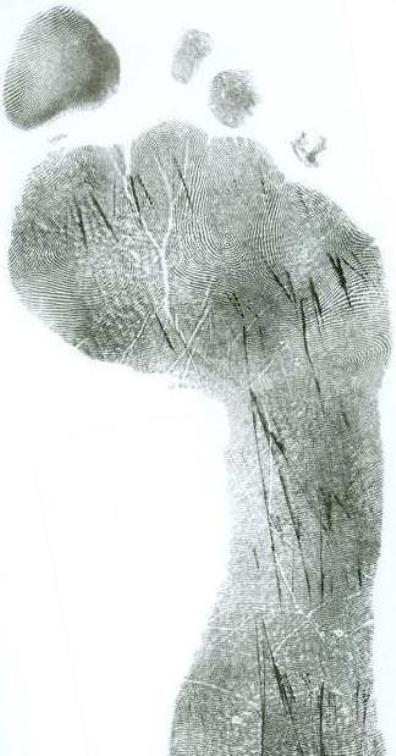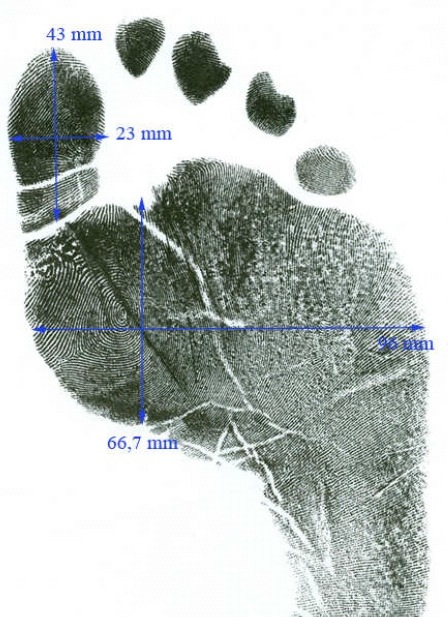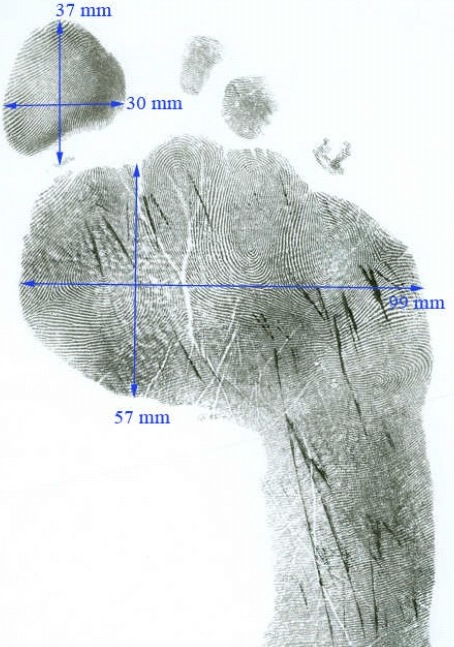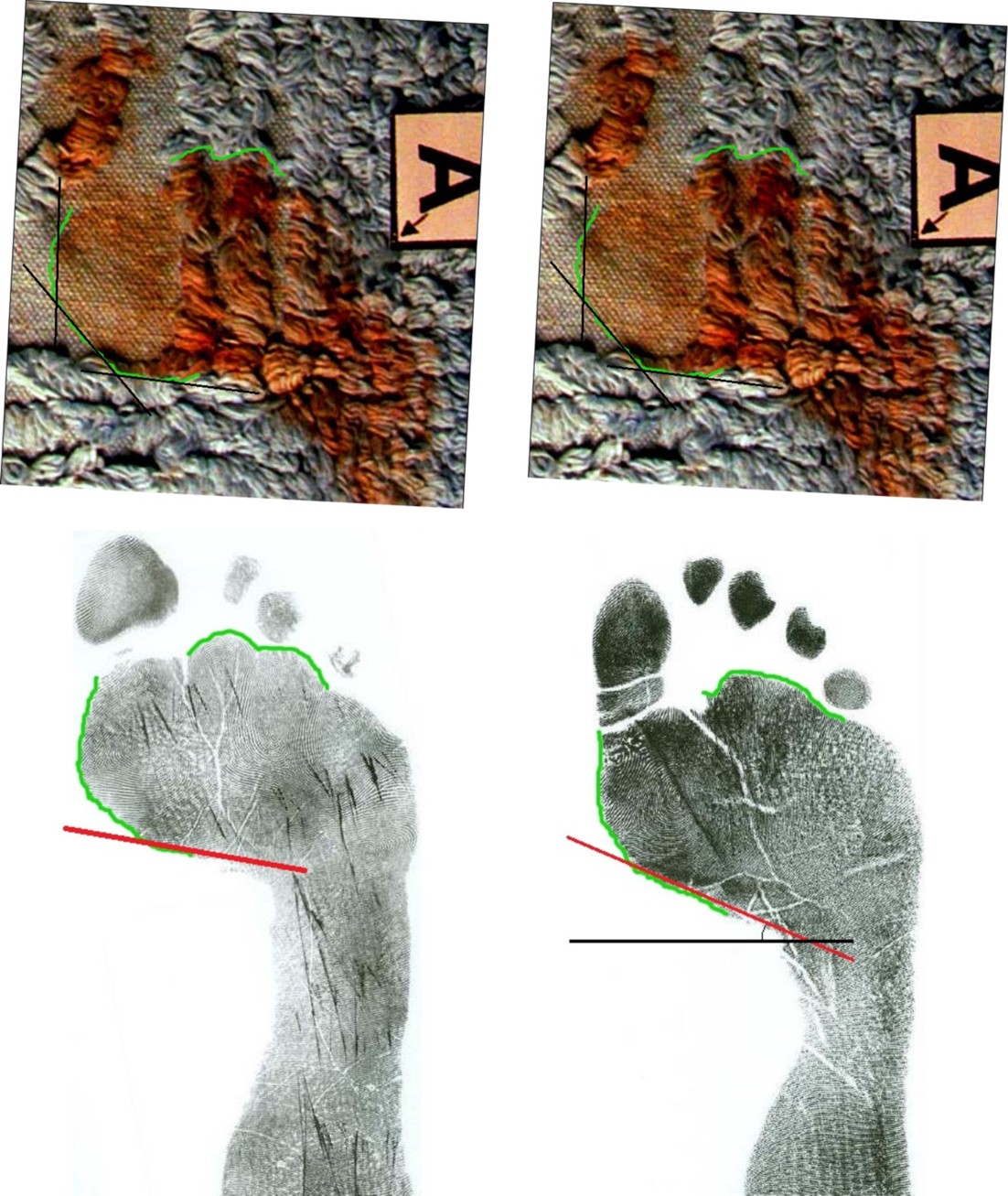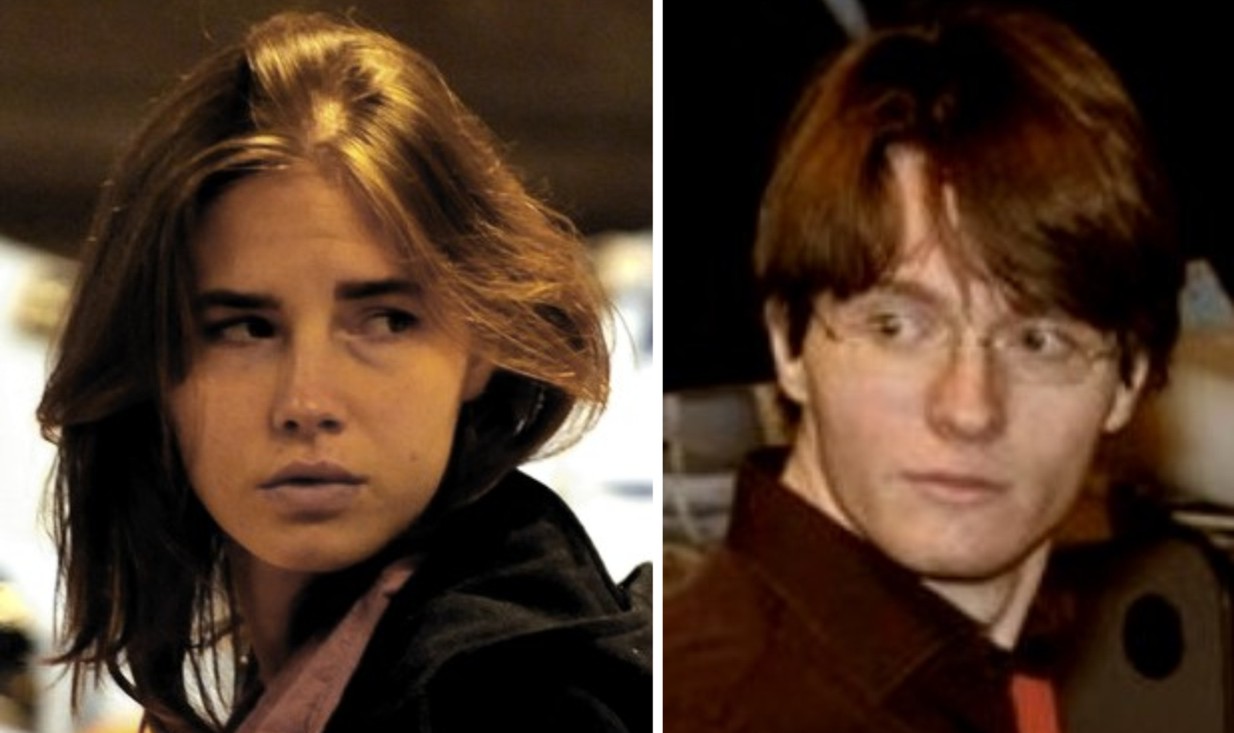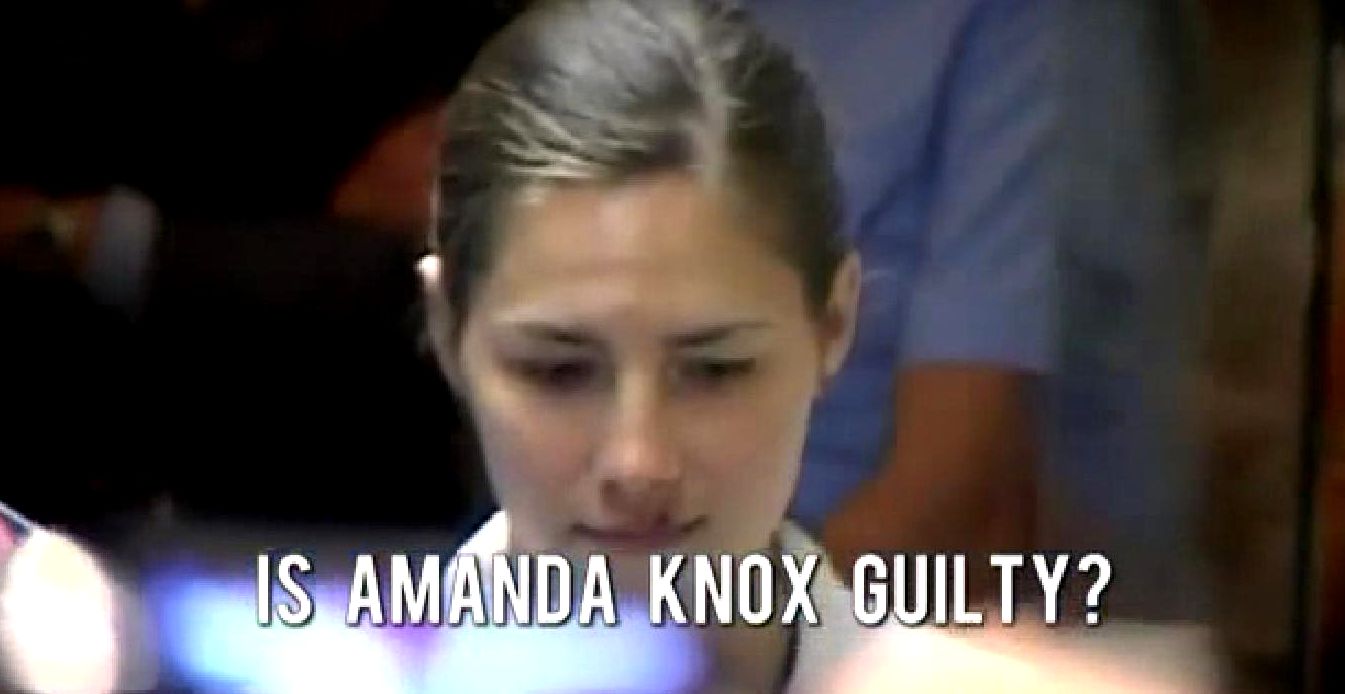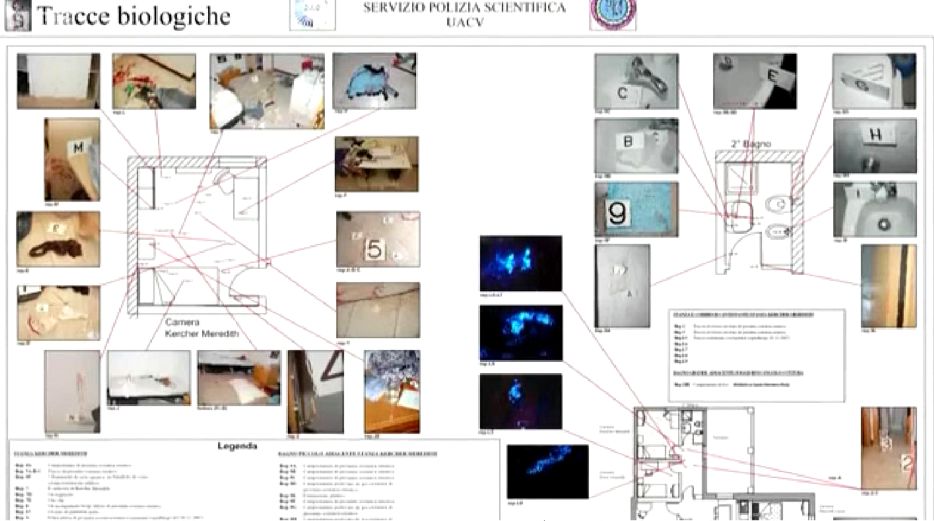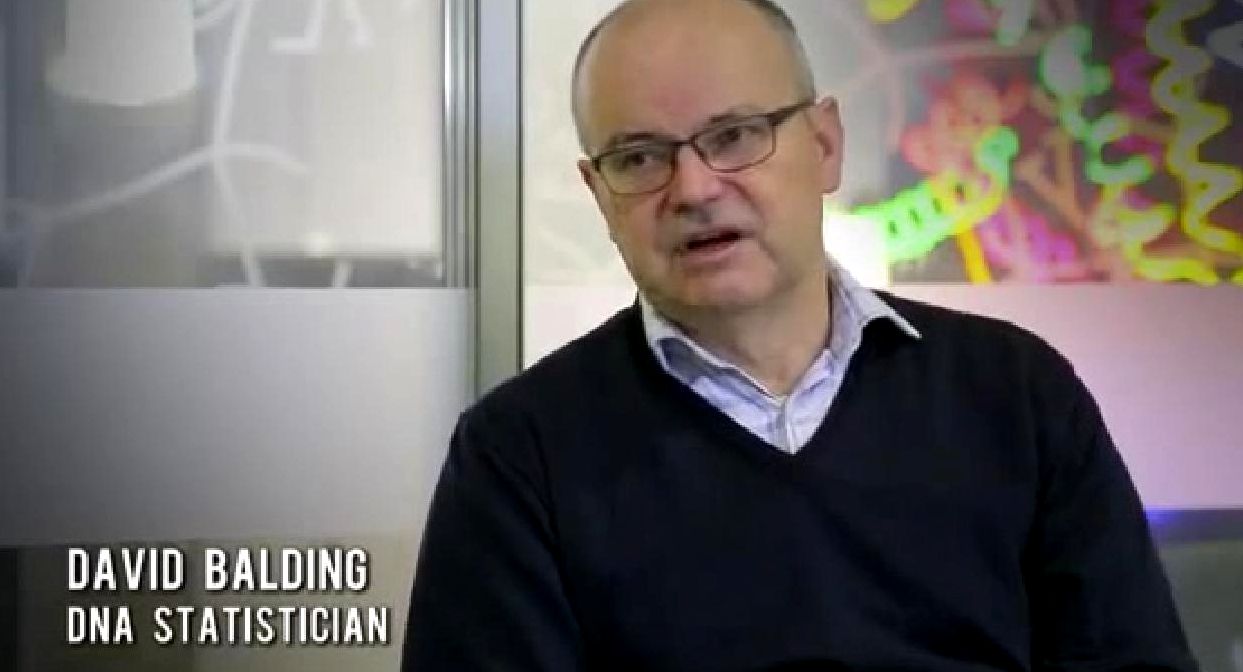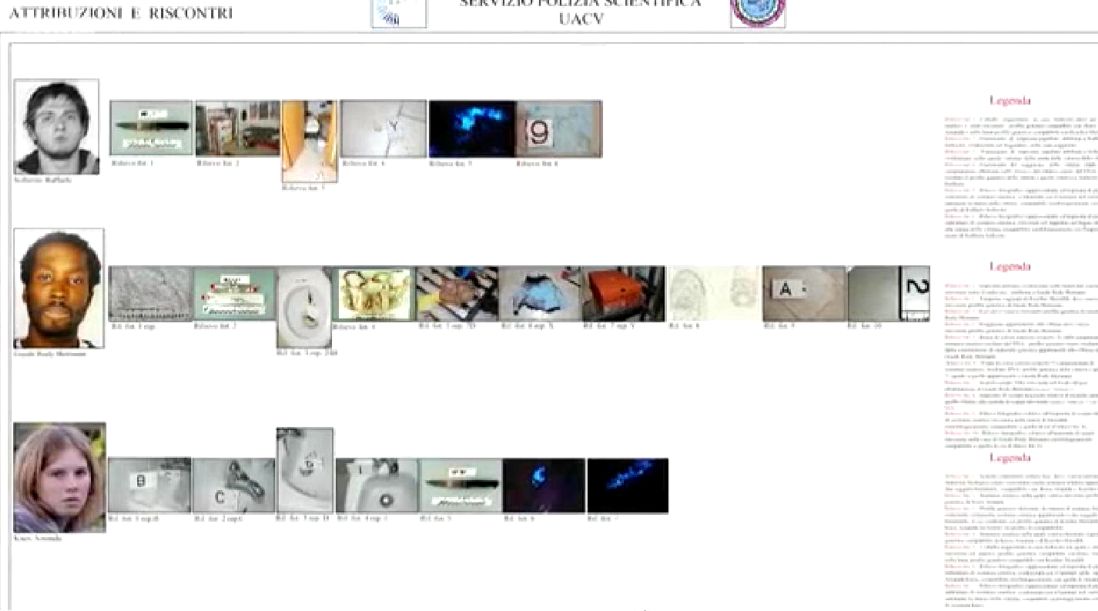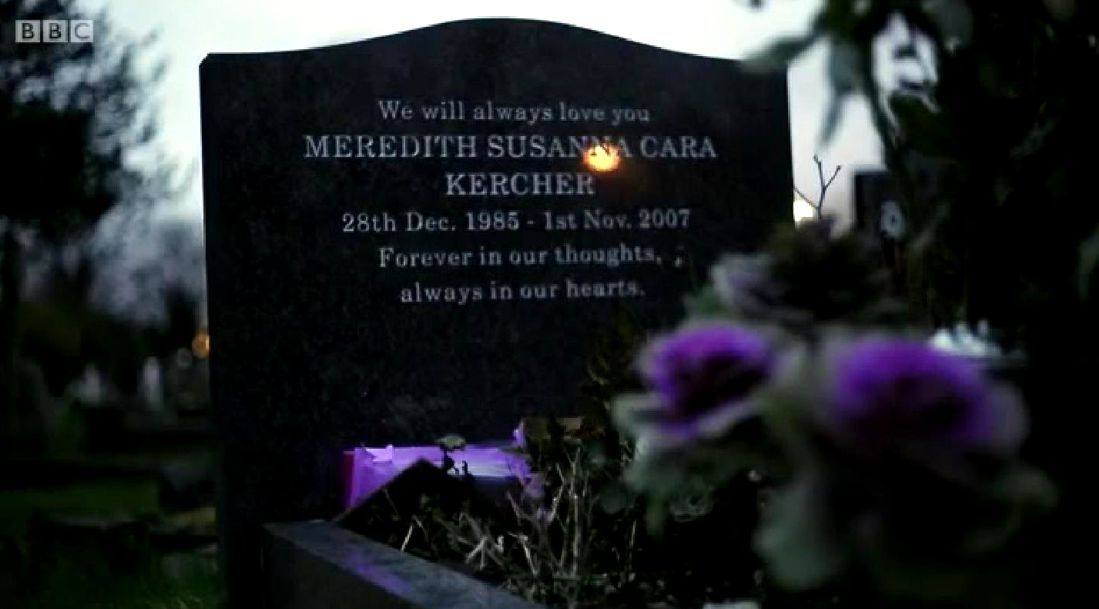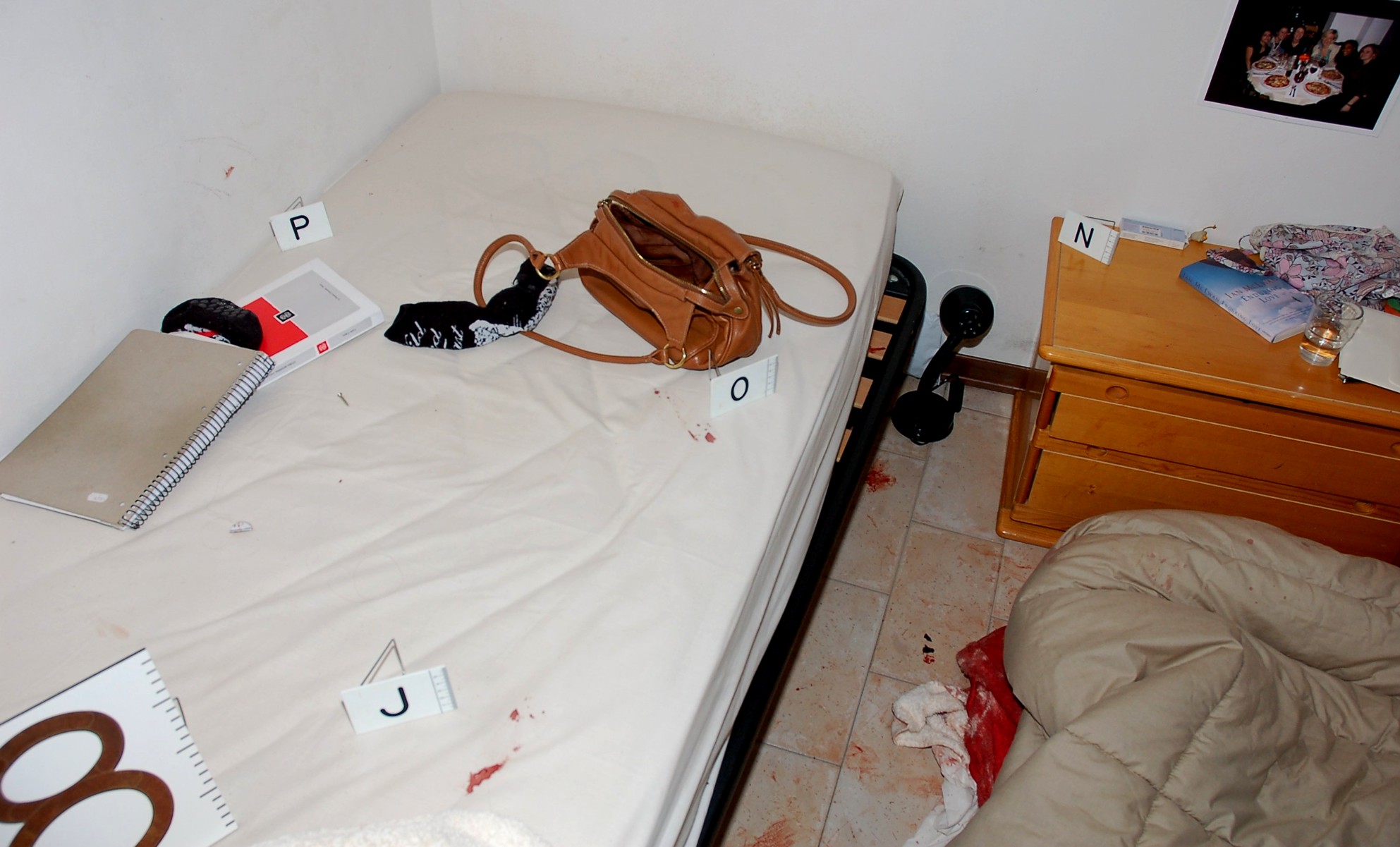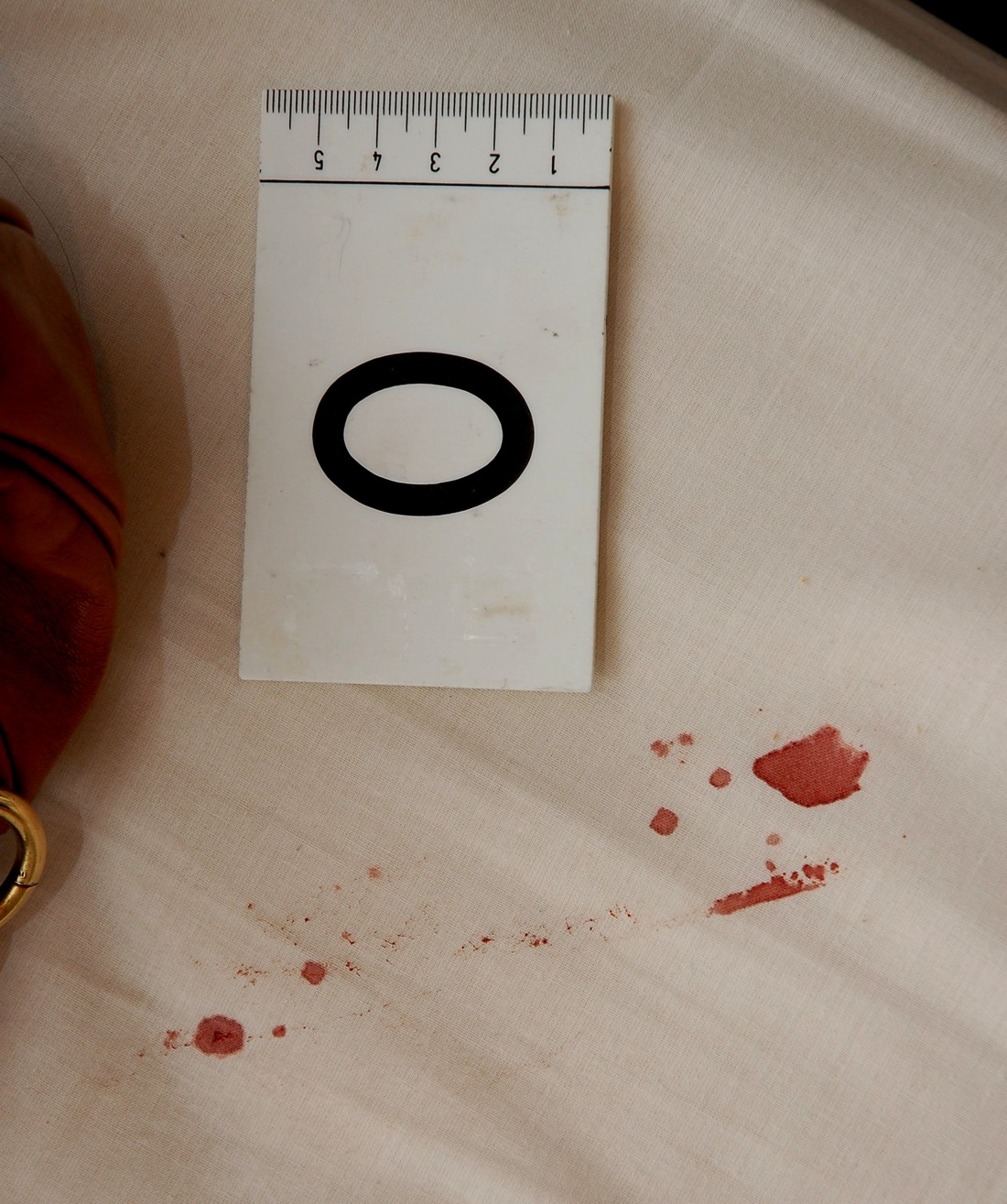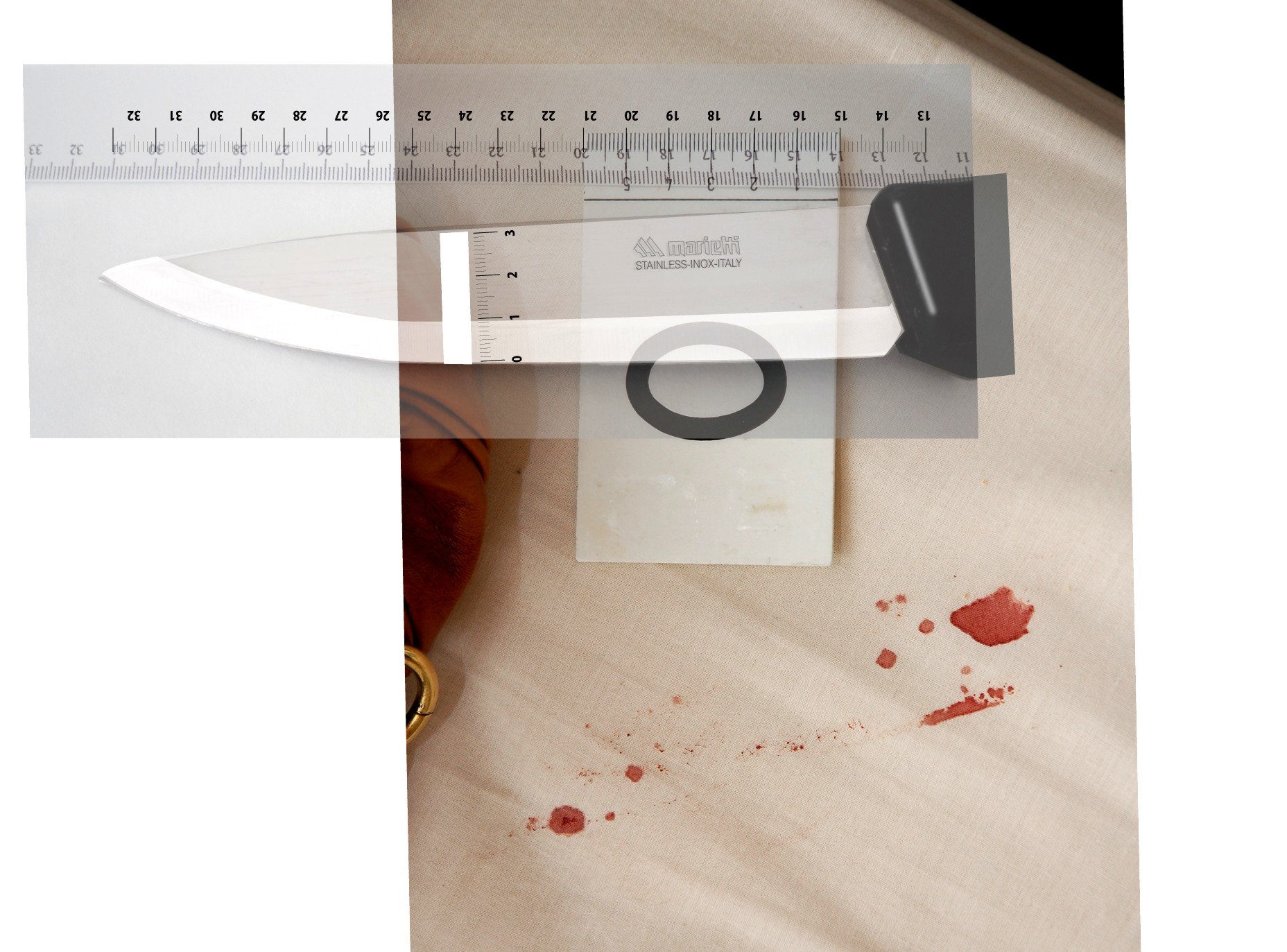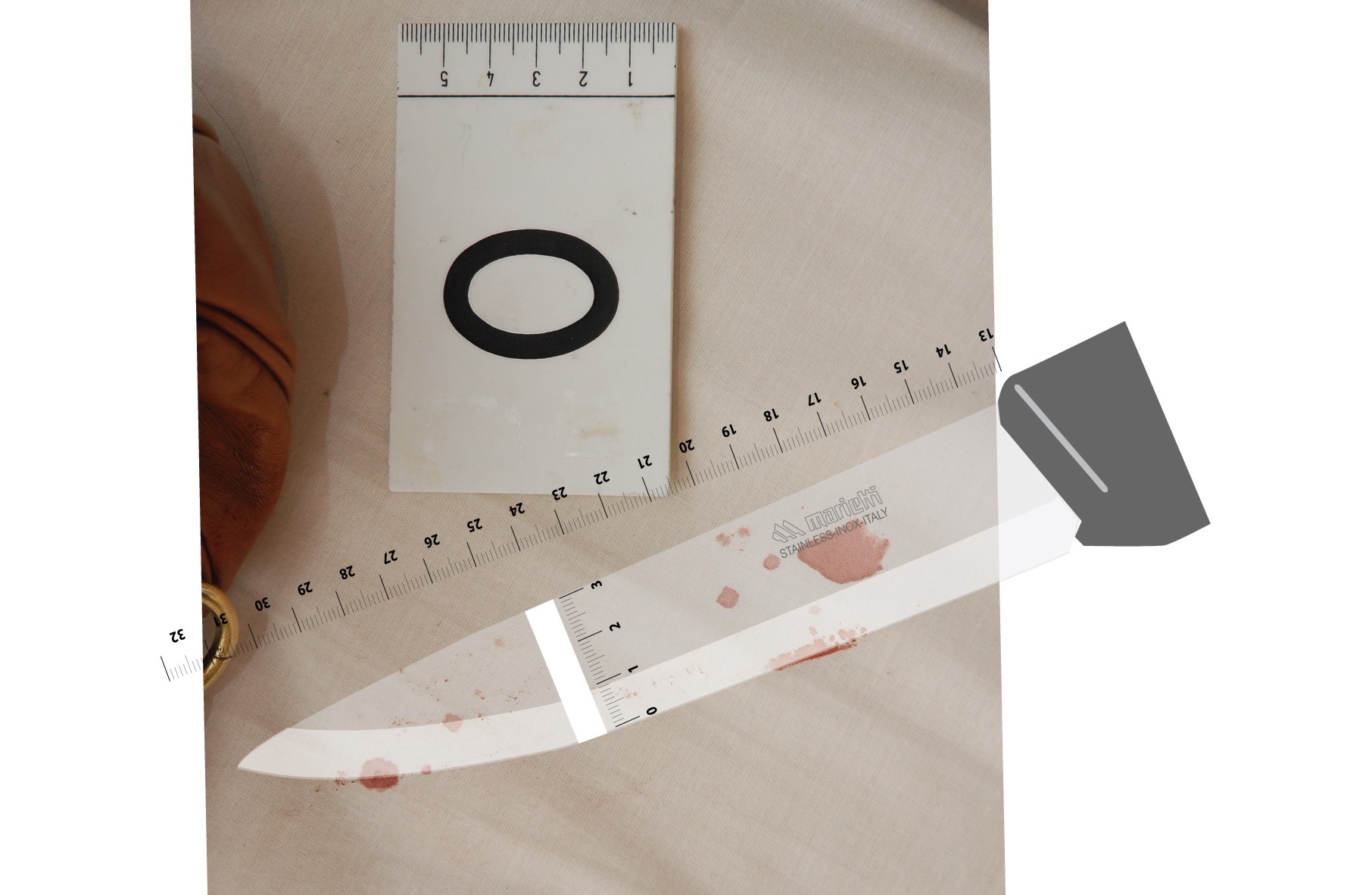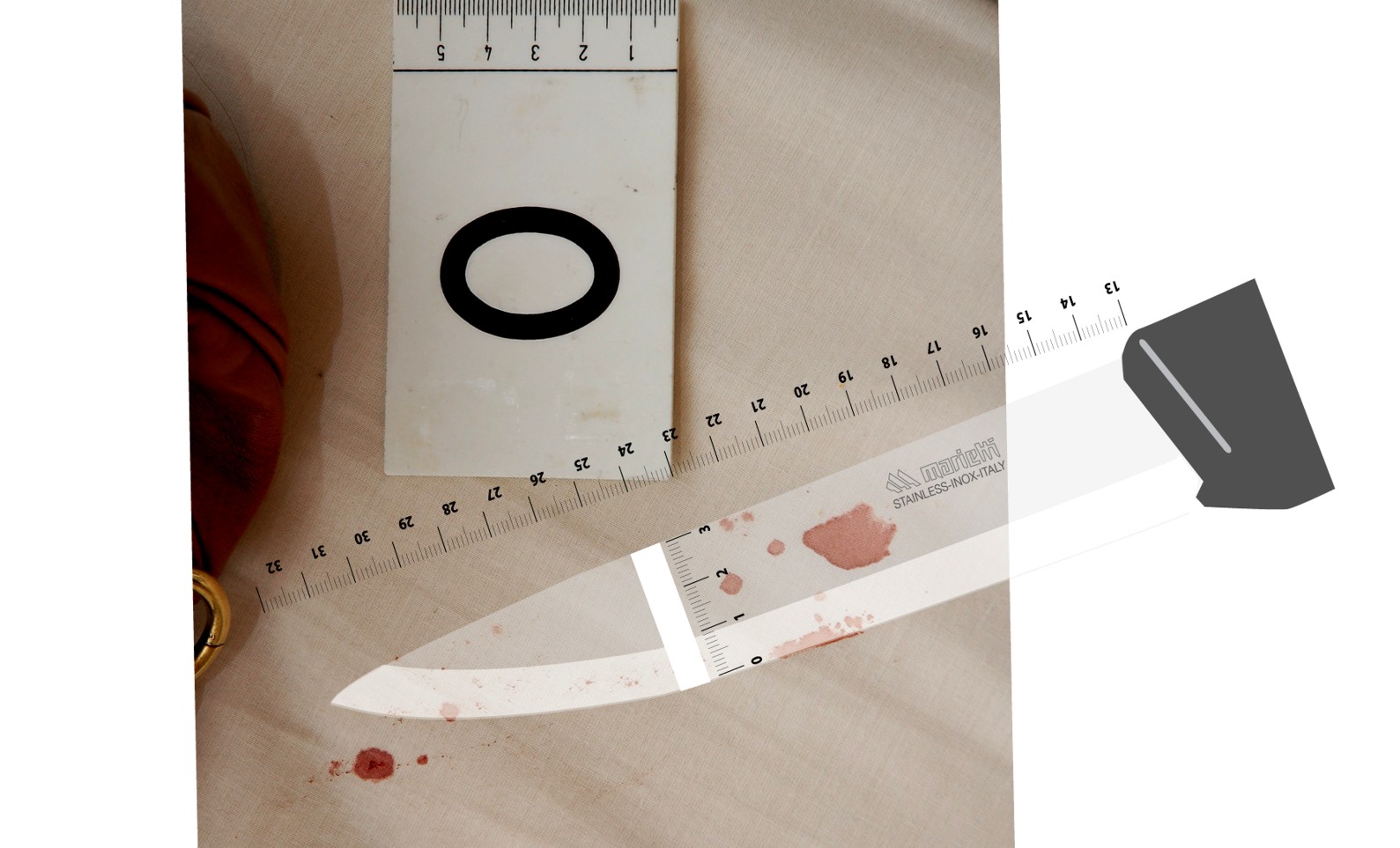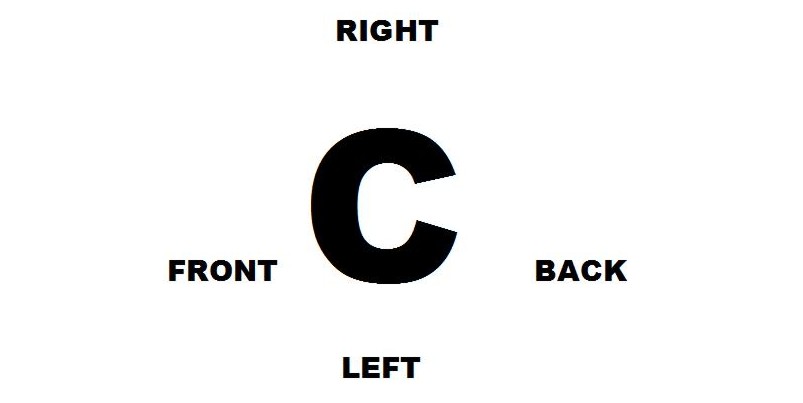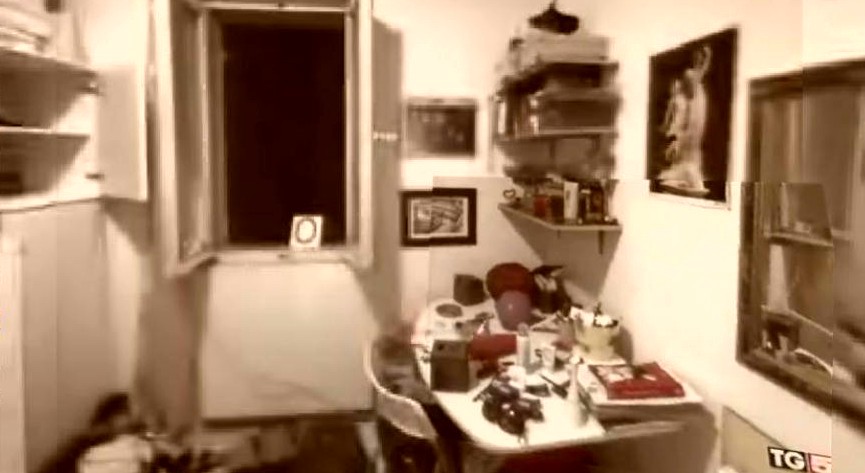
Category: 33 Sole attacker hoax
Wednesday, April 16, 2014
The Incriminating Bathroom Evidence: Visual Analysis shows the Footprint IS Sollecito’s
Posted by Machiavelli
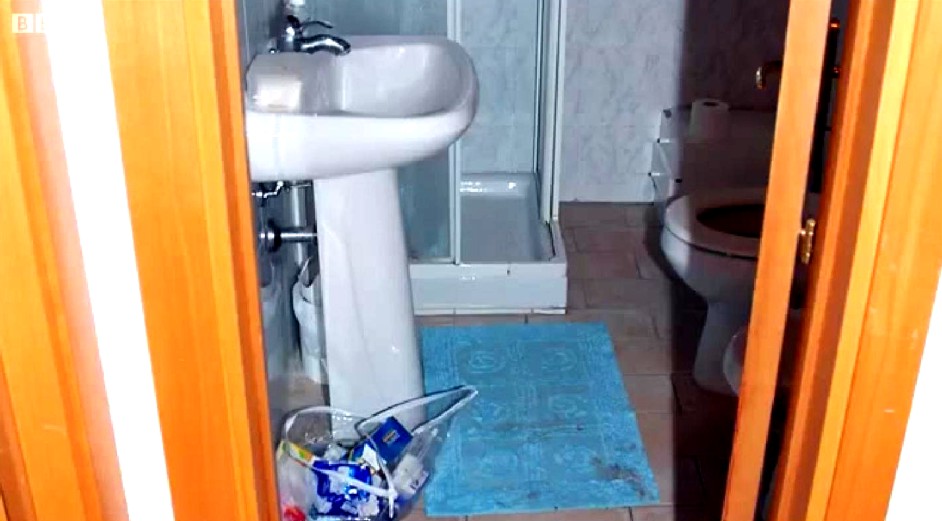
[Please click on each image for a larger and more high-resolution version]
The sheer depth and width of the hard evidence
The defenses really don’t want you to know this: in both width and depth, the full panoply of the evidence against Knox and Sollecito is absolutely overwhelming.
As we remarked in our post below there are far more and far stronger evidence points than UK and US courts normally require for conviction. But only the trial panel of judges observed anything like their full array.
The 2010 Massei Trial Report (which the Nencini Appeal court validated this past January) is a SUMMARY of what was presented to the judges in the courtroom. Those presentations in court were in turn something of a SUMMARY of the hard evidence buried in all the evidence files and the minds of witnesses.
Italian media SUMMARISED for Italians what was to be seen in the courtroom and to be read in the Massei Report. They were barely able to do even summaries for the 1/4 of all the trial hearings that were not open to the media or the public.
UK and US media for the most part didn’t even bother to provide comprehensive summaries (the very fine on-the-spot reportings of Andrea Vogt, Barbie Nadeau and Ann Wise were the main exceptions).
So in effect people in the UK and US attempting to follow the story didnt for the most part receive even a summary of a summary of a summary!
Not one US or UK newspaper or TV network translated the Micheli Report, or the vital Massei Report, or the Supreme Court appeal, or the Supreme Court outcome - only the (mostly professional) translators on PMF dot Org did all that translation.
This post is another example of how far down - beyond even Massei - it’s possible to drill into the evidence, and see it still hold up.
Some past posts on TJMK drilled down to similar depths, on the knives, on the DNA, on the mixed-blood traces, on the phone-events, on the motives and psychologies, and so on. All that evidence too all held up.
Visual analysis of the bathroom-mat footprint
This post mainly consists of high-resolution pictures and measurements. Presented like this, the pictures and measurements largely speak for themselves, and show the real strength of the bathroom-mat footprint evidence.
You will see that as SomeAlibi previously concluded using other methods, this footprint was quite undeniably Sollecito’s. It bears no similarity at all to Rudy Guede’s.
Please click on all images for larger versions in scalable PDF format
1 . [Below] the bathmat and the print, with measurement reference
2 . The bathmat print and the surrounding area
3 . The bathmat print (photo from Polizia Scientifica).
4 . The bathmat print, with vertical and horizontal sizes, from Rinaldi’s report
5. The bathmat print, photo with enhanced contrast.
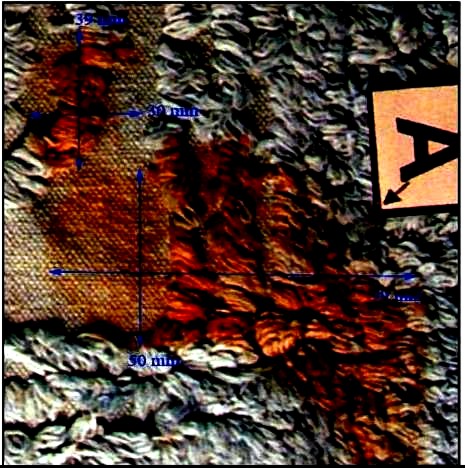
The photo above was modified by highly enhancing contrast.
6 . Enhanced contrast helps to spot some features
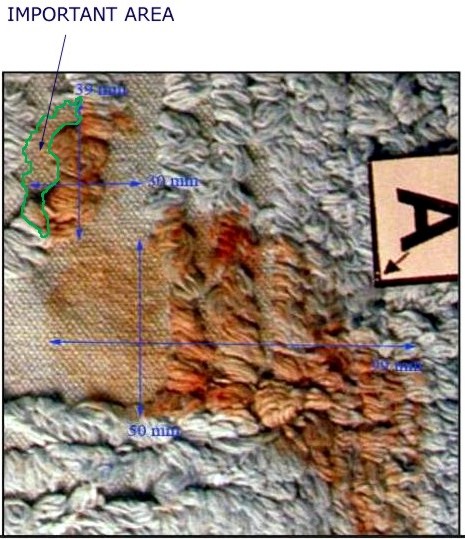
Contrast may help to highlight especially some parts of the print outline.
For example the area on the left labeled as “important area” in the picture (which was “forgotten” in the notorious photo elaborations disseminated by the ‘Friends of Amanda’ group), shows the actual left outline of the “˜big toe’ of the bathmat print.
The toe includes the area indicated in this picture (here the picture is shown again in its original colours).
7. The bathmat, with enhanced contrast
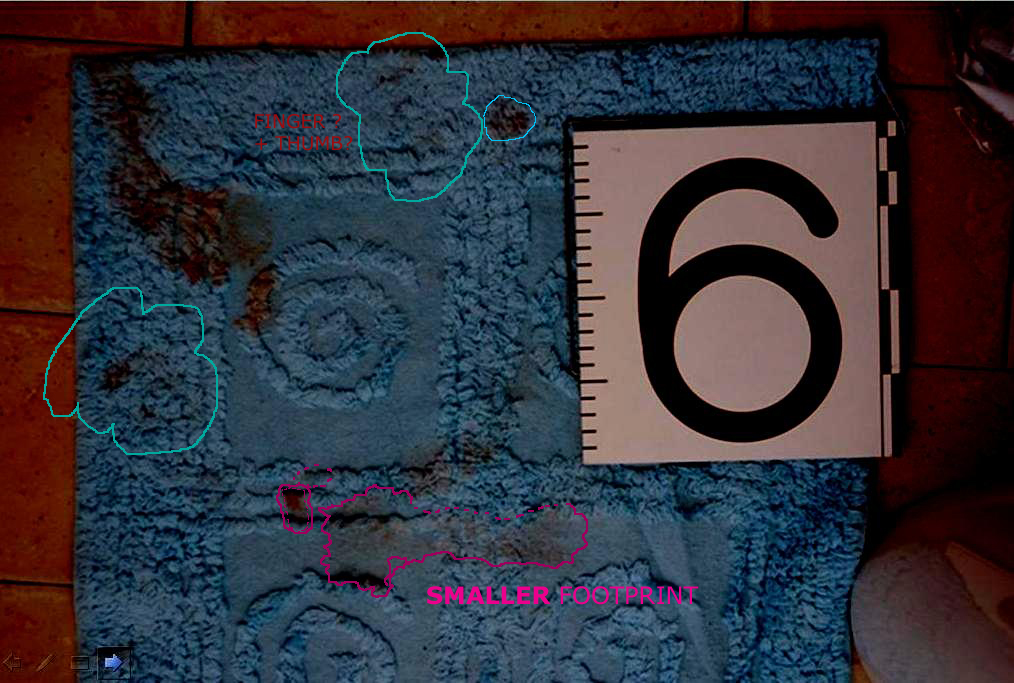
The contrasted image is showing the presence of other stains
There are other stains on the carpet (about another 10, factually situated in one half of the mat area), and also there shows a second diluted footprint (apparently from a foot of smaller size).
8. The selection of a set of red colour shades, outlined by an automatic outline generator
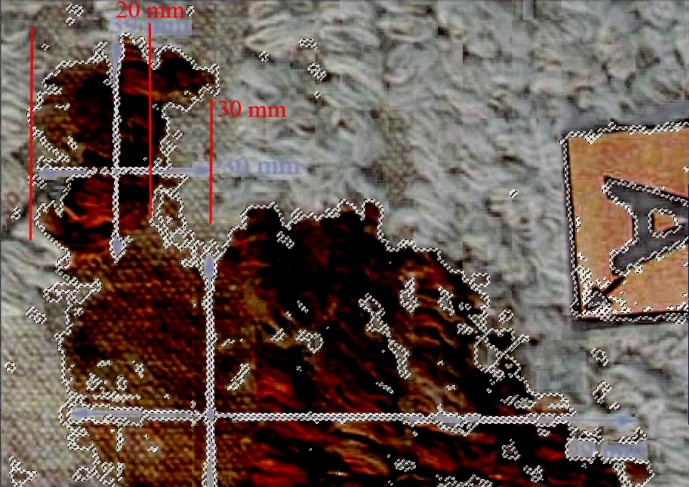
Shows the shape and the possible “˜outline’ of the stain
Reference measurements indicate the width of the “˜big toe’ in millimetres.
9 . A hand drawing of the outline (detail).
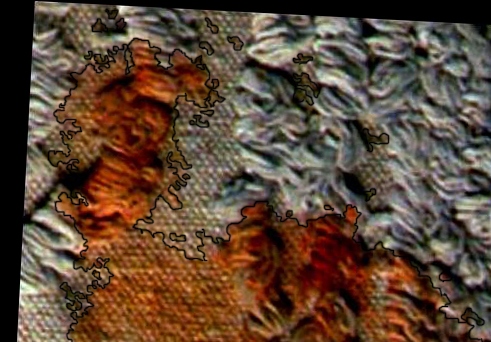
The photography above was modified
The modifications are: +28% contrast, -8% luminosity, + 20% colour saturation, from the original.
An outline has been drawn manually on the photoshop image, trying to be as faithful as possible to the actual stain.
You can notice that, apart from some minor “˜disputable’ very faint areas (such as the area between the toe and the metatarsus) there are only minimal differences between an automatically generated outline and a manually drawn one.
The shapes of the “˜big toe’ are extremely similar in both contours (images 8 and 9), in fact all meaningful features are basically identical.
We consider this manually drawn outline as good for comparison.
10 . The complete hand-drawn outline
11 . Minor detail: small dots separated from the main stain
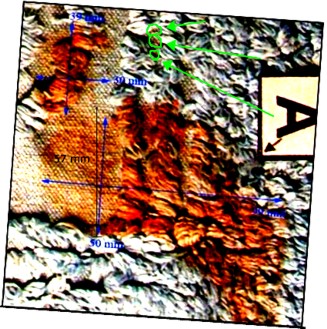
Observe the small red ‘dots’ in the picture above
Although we can’t draw any conclusion about their possible significance, we note the existence of these very small “˜spots’ of a faint red colour shade, separated from the big stain.
They are detected by the computer generated outline above, and that we also see as distinguishable with the naked eye thus we considered them in drawing manually the outline.
We don’t draw any conclusion about them; but because of their sensitive position (they may suggest a “˜small toe’ mark) we take note of them.
The green arrows in the picture point out their position (green circles).
12 . An image in electronically modified colours
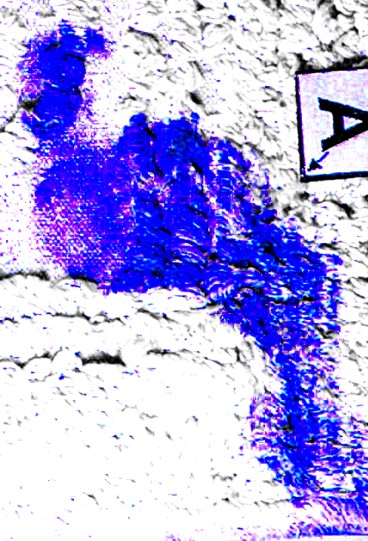
Distribution and intensity of the colouration
As a part of the preliminary study of the stain, we also produced this image above where the computer assigned an artificial colour to an array of shades of ‘red’, thus allowing to further isolate the stain from the background for further assessments about its shape.
This picture shows the distribution and intensity of the colouration. (note: the existence of some above mentioned tiny marks is recorded by this technique too)
13 . The bathmat has a spiral-shaped relief decoration
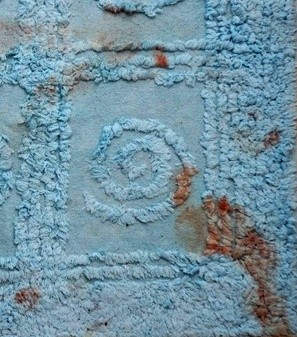
The footprint’s toe obviously balancing on top of the relief decoration.
We think the outline of the “˜toe’ mark of the bloody footprint is affected by the shape of the decoration, in particular the missing part of the toe on the right side, which is remarkably coincident with the margin of the decoration.
So that on that side there is a striking correspondence between the outline of the “˜negative area’ ““ the fabric surface around the spiral, which is lower ““ and the big toe’s outline
This indicates that the outline of that mark on that side was affected by the decoration margin, thus the print there has a “˜missing part’. So the “˜crooked’ bloody area in fact follows the margin of a larger toe.
Because of such coincidence, we can logically assume that the actual shape of the big toe mark appears to be part of a big toe, with larger surface which left its print only partly because part of its surface did not have contact with the fabric, in correspondence of the “˜negative area’.
14. The “negative area”
15. Mat decoration in relief and the toe mark
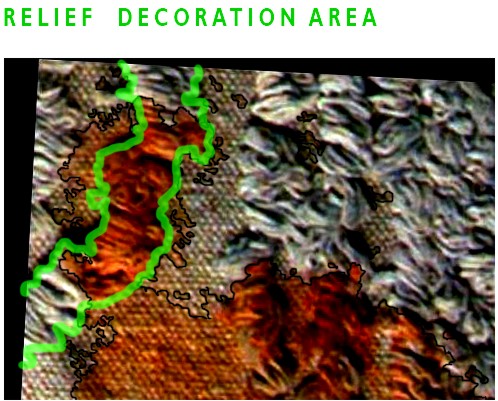
Observe above one single, unitary stain
The remarkable coincidence between the outlines of the decoration in relief and of the toe mark is shown in the picture above.
The rough contour of the print obtained through a smooth curve highlights the shape of the big toe.
Part of the relief decoration outline coincides with the toe mark outline, which shows, highlights and explains how all parts of the red toe mark, that you can see left of the relief decoration, they all belong to one single, unitary stain.
Thus we can deduce that the “missing” area on the right of the toe is determined by the decoration, and coincides with the negative area.
16. Picture (by Kermit) showing a rough shape of the stain
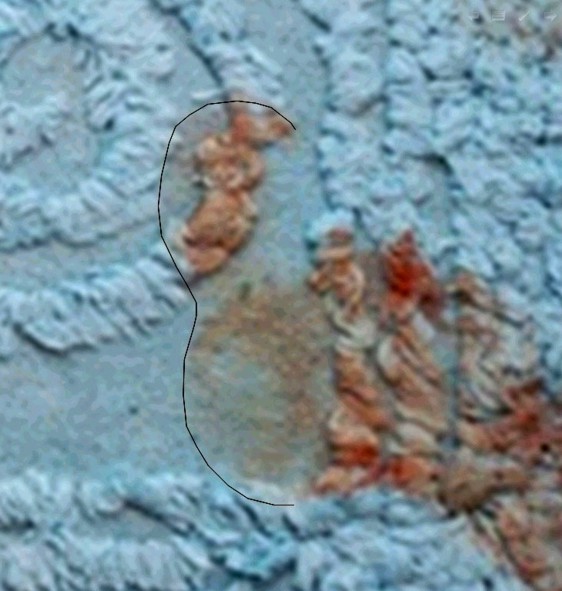
Observe shape, curvature and size
This drawing by Kermit above highlights the rough shape, curvature of left margin and overall size of the big toe.
17. Rudy Guede’s sample print
A copy of this picture together with one of Sollecito’s print at the same scale will be used for comparisons.
18 . Raffaele Sollecito’s sample print
A copy of this picture together with one of Guede’s print at the same scale will be used for comparisons.
19. Part of Rudy Guede’s sample print with Rinaldi’s reference measurements
20. Part of Sollecito’s sample print, with Rinaldi’s reference measurements:
21. Bringing all photographs down to the same scale
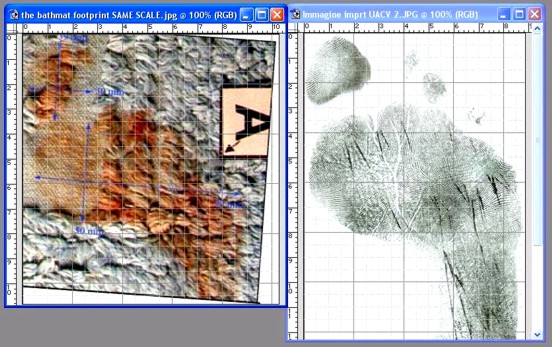
An accurate exercise of scaling was done
This was based on Rinaldi’s referenced pictures. Each one of the Rinaldi’s sample pictures has multiple measurements on several points of reference which allow a high precision determination of their scale and sizes, and thus comparison at the same scale.
In order to further increase scaling precision, the scale was calculated previously and separately for each comparative measurement in the three photos; this was done multiple times for each measurement and the average was picked in order to reduce error as for statistical measurement method.
The resulting final error in the scale is extremely small, far below a threshold of significance that could affect comparison (which was set arbitrarily at 1%, but it’s probably significantly higher, while the actual error is much lower).
In other words, the scale error that may affect your screen pictures will be definitely smaller than any possible perceivable (either significant or tolerated) difference that would be noticed or that may affect the attribution of the stain, when this is compared to the sample.
22. The hand drawn outline is shown again here
23 . The outline (matched scale) overlapped on Sollecito’s sample footprint
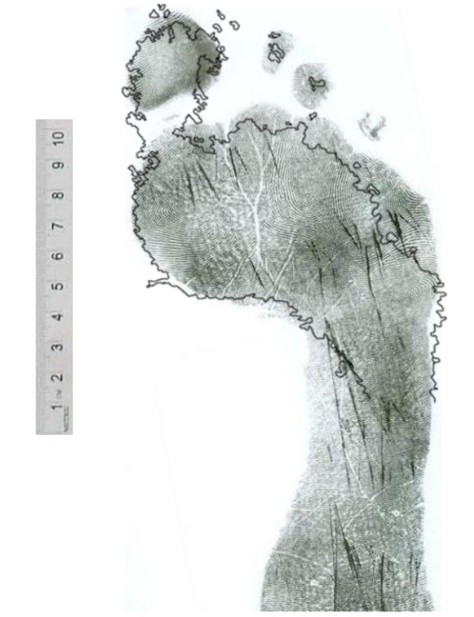
The array of compatibilities with Sollecito
The bathmat stain does not seem to have major incompatibilities with Sollecito’s print; it shows rather an array of compatibilities that can be perceived visually.
One interesting feature is the shape, size and position of a ‘big toe’, that appears as a remarkable coincidence; the toe also has a kind of cleft (see 28 below) on the curvature of its left margin. Another outstanding coincidence is the curvature of the plantar arch on the left.
24 . The same outline overlapped on Guede’s footprint
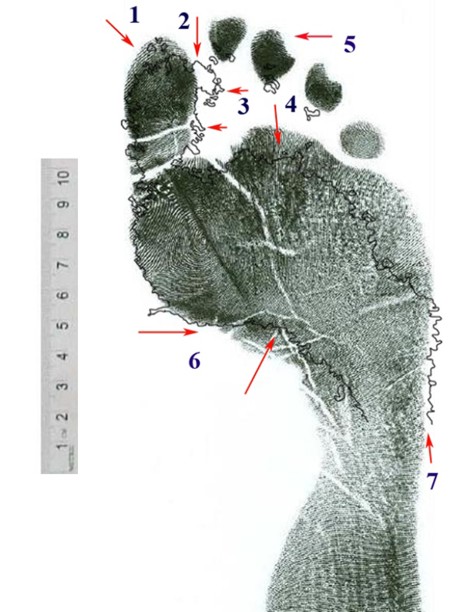
Compare with Guede’s - matched scale.
If you look at the overlapping of the stain outline (see pic 22.) with the sample of Guede’s print (see pics 17. 19.), you may notice 7 major differences, showing a failure of compatibility. Those differences are indicated by numbers (1-7) in the picture .
Each one indicates an area of major difference between the outline of the bathmat stain and the outline of Guede’s sample print. Those measurement differences are remarkably larger than those that can be detected on the overlapping with Sollecito’s sample print.
On the other hand, the compatibility between Sollecito’s print and some very peculiar aspects of the bathmat print (such as a 30mm wide and short toe) were absolutely remarkable.
The differences between the bathmat stain and Guede’s print are :
1) Toe mark of stain is significantly SHORTER than the big toe in Guede’s sample print (a difference of about 7 millimetres). Some people may want to attempt an objection, by suggesting that such a difference may be just a consequence of the position chosen for the overlapping, that maybe the bathmat print was just positioned too low in the picture, the problem may be solved by shifting it up about 7 millimeters so as to make the tip of the bathmat toe ‘coincide’ with the tip of Guede’s print toe.
However, such objection wouldn’t work; it’s a wrong argument. In fact the only possibly correct position for overlapping the bathmat stain outline is determined by the left curvature of the ball of feet and plantar arch (the area of the picture near number 6), which is by the way the most clearly outlined part of the bathmat stain. If you shift the bathmat stain upwards, the outline will miss the match with the curvature of the left margin of the ball of the feet. You will notice that the plantar arch in this area is already very incompatible with Guede’s plantar arch. It tends to become even more incompatible the more you shift the bathmat stain outline towards the toe.
The problem has no solution, since the more you shift the stain outline upwards (in the direction of the toe) in an attempt to make it look more ‘compatible’ with the length of Guede’s toe (or with an upper margin) the more it will become incompatible with the plantar arch. In order to limit the incompatibility of the plantar arch, and in order to keep an overlapping of at least the left margin of the ball of the feet, you need to place it as shown in the picture, this is the position of ‘maximum’ compatibility between the bathmat stain and Guede’s print. Conclusion: the bathmat toe is too short.
2) Toe mark of stain is TOO WIDE (30 mm). It is much wider (30 mm) than Guede’s toe. The number 2. indicates the protruding mark at the upper right, the mark which Giulia Bongiorno desperately insisted on calling a “second toe” mark. In fact, not only would the mark miss completely any hypothetical Guede’s ‘second toe’ in any possible position of the print; also you may notice (highlighted by pics 8. and 9.) how it is not a “mark” itself, but actually it just part of the same area which is entirely continuous in shape and coloration with the rest of the toe mark, and - the most remarkable feature - its right outline is coincident with the outline of the spiral-shaped relief decoration, so that you can reasonably conclude that it is determined by that (the missing area at the lower right of the ‘big toe’ is determined by the existence of the “negative area” of the bathmat decoration).
Conclusion: the bathmat stain has a wider toe mark, however one likes to call it (“big toe”, or “big toe + second toe”) that fails to match any possible part of Guede’s print. The bathmat print is clearly different and incompatible with Guede’s print. It simply cannot be overlapped to any part of Guede’s sample print. Such area is a very significant difference that points outright to incompatibility between the stain and Guede’s print.
3) The toe mark is larger also in the area located at the lower portion of the toe. The toe of the bathmat print in fact has a ‘right margin’ which actually has some additional small marks, small drops protruding towards the right, like droplets maybe produced by the wet cotton fibres of the part in relief which protrude towards the right. This tends to suggest the toe area of the stain may in fact be considered wider: the object that produced it was definitely wider than 22mm, in this area of the toe as well. So also a look at this area confirms that the bathmat stain is wider than 22-23 mm (more towards 30 mm) not just when measured at the upper corner (number 2.) but also at its “lower” parts; here, the small marks caused by the liquid suggest that a larger surface has squeezed liquid from some fabric threads leaving some trace also on the lower area.
4) Bigger incompatibility of Guede on the metatarsus front outline. This area is the front outline of metatarsus: the stain is almost 1cm shorter than Guede’s metatarsus. This happens when you chose the overlapping so as to make the left outline and plantar arch (6.) of metatarsus coincide, as in the picture. Sollecito’s sample print also shows some difference from the stain in this area (pic. 23.) but the difference between the stain and Sollecito’s print is significantly smaller than what you can see in Guede’s print.
5) There are NO SMALL TOES in the bathmat stain. Small toes are completely absent from the bathmat stain (while the tiny blood marks around the stain don’t coincide with their expected position if it was Guede’s print). Such lack of small toes is a peculiarity of the bathmat print. This is a remarkable difference from Guede’s print, and at the same time, a considerable analogy with Sollecito’s print. In fact one outstanding feature of Guede’s print is the evidence that Guede places a big load of weight on his small toes while instead Sollecito has a posture with a weight distribution with the contrary tendency, and obviously he almost does not touch the ground with his small toes.
Thus, Guede’s small toes are all very well pressed on the ground and thus, we can reasonably infer they are somehow naturally likely to get wet if he steps on any wet surface, and anyway they should get wet for sure if the foot is immersed in water or washed (the foot that left the bathmat print must have been immersed in bloody water). The murderer supposedly washed his foot then stepped on the bathmat. In order to attribute the print to Guede we should assume that Guede “forgot” to touch the carpet with his small toes (while instead he puts a lot of weight on them) or that he managed to not rinse them.
6) The outline of the stain has a PLANTAR ARCH that COINCIDES, by curvature and angle, with the plantar arch in Sollecito’s print, while instead it is very different from the plantar arch of Guede’s print.
7) The stain is larger than Guede’s print metatarsus as visible in the right area of the stain. The difference is rather significant, almost half a centimetre, that is bigger than the difference with Sollecito’s print which instead coincides for a trait. This difference cannot be “solved” in any way since, even if one wanted to claim that the scale is wrong and that the stain should be sized down, this would make the toe, already too short (as in 1.) become even shorter.
If instead the toe length is adjusted the metatarsus becomes even less compatible with Guede. We recall that Massei found that Guede’s feet had a print overall more slender than Sollecito’s.
25 . Other features:
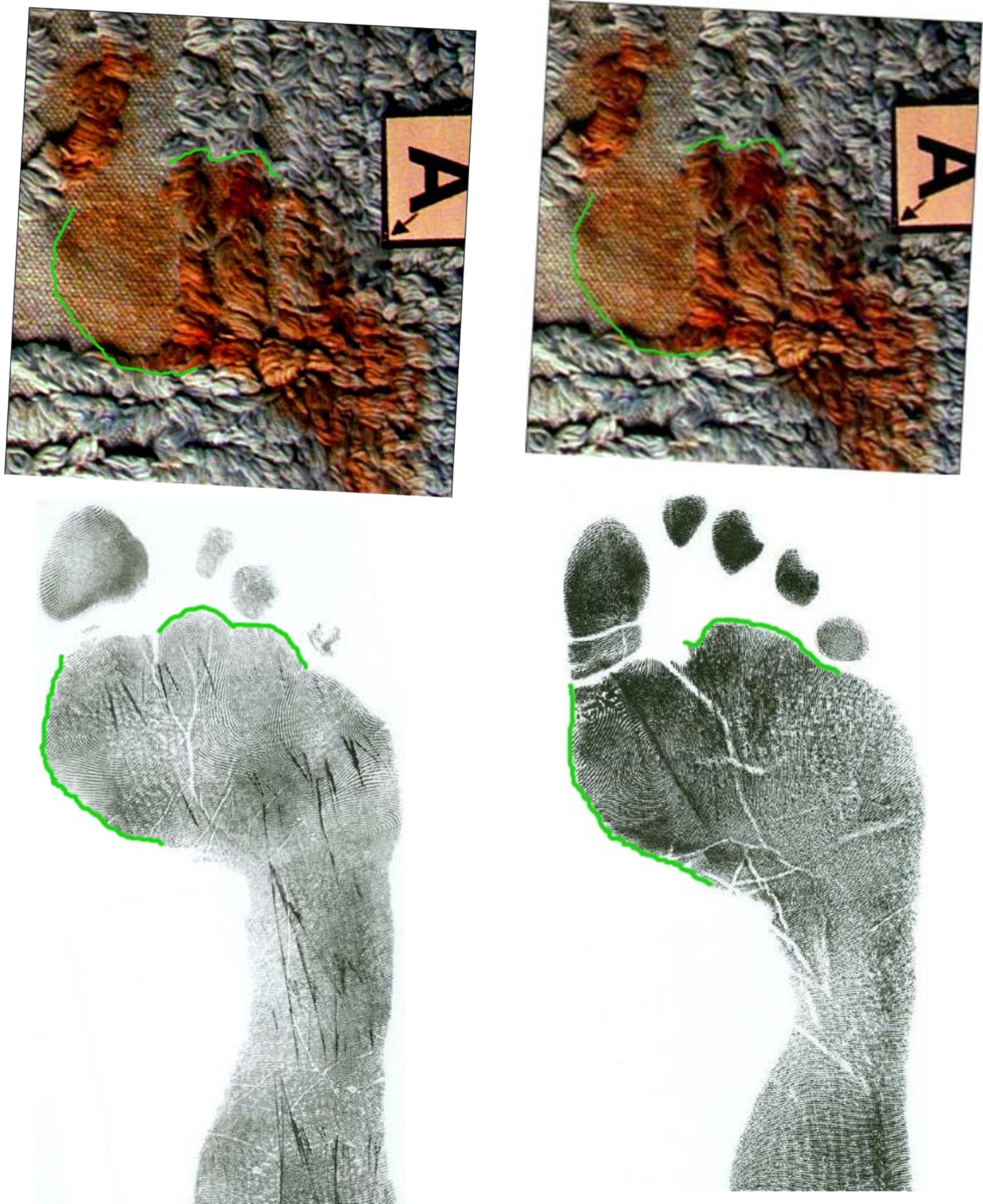
Curvatures of plantar arch are very different
The plantar arch curvature, highlighted in two different drawings (the second highlights also the upper outline “hunches”); the plantar arches in the two sample prints of Sollecito and Guede are shown below. The curvatures of plantar arch are very different.
26. The outline curvature generates different angles
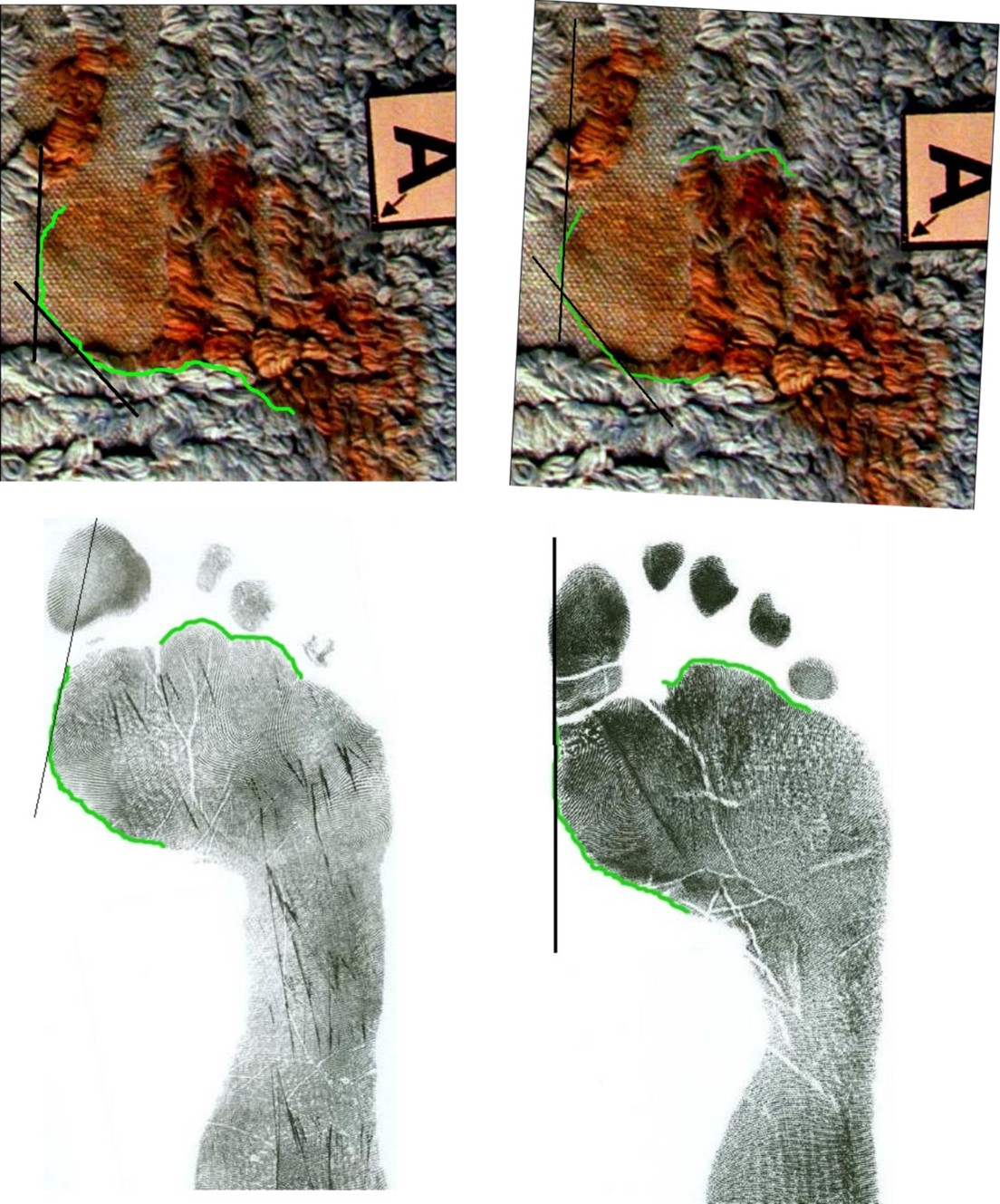
Sollecito’s and Guede’s plantar arch curvatures have very different angles. Also the left outline of metatarsus maintains a different curvature. Sollecito’s outline has an angle (see outline tangent) intersecting the toe (the metatarsus has a “bunion”); in Guede’s print there is basically no intersection, the outline and the toe form almost a straight line.
27 . Plantar arch curvature angle differs between Sollecito and Guede
If you consider the vertical axis of the sample footprint, and its orthogonal line, you may notice how the plantar arch curvatures of the two prints accomplish different angles: the two angles are VERY different, not just three or four degrees.
The (too) narrow angle of Sollecito’s plantar arch probably has a relation with the protruding outline and angle seen in pic 26., and seems related to a hallux valgus (which Guede does not have).
28 . The “cleft” on the left side of the stain
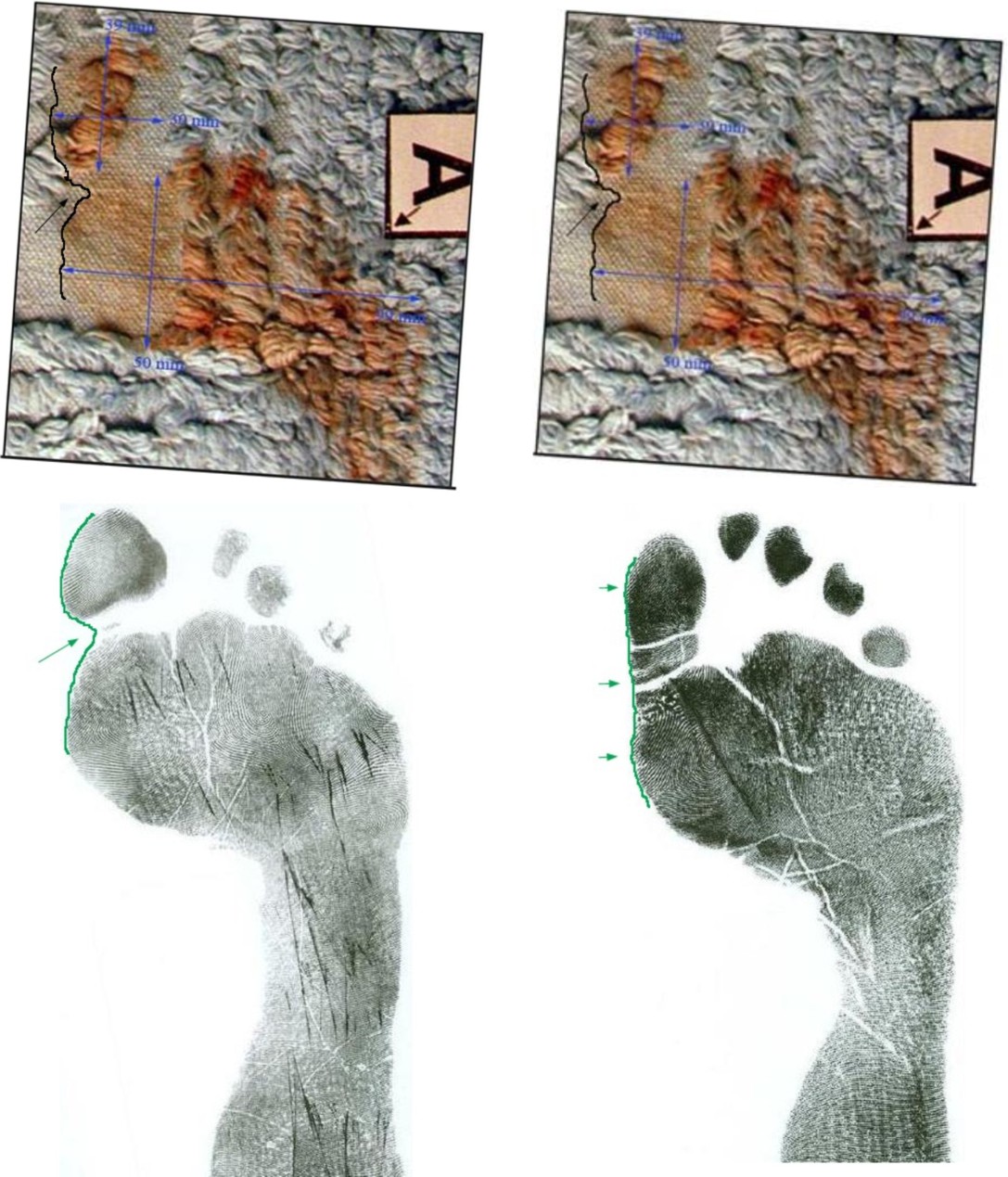
The “cleft” on the left side
This has a correspondence with one sample print, not so with the other.
29 . Table of metric comparison (by SomeAlibi)
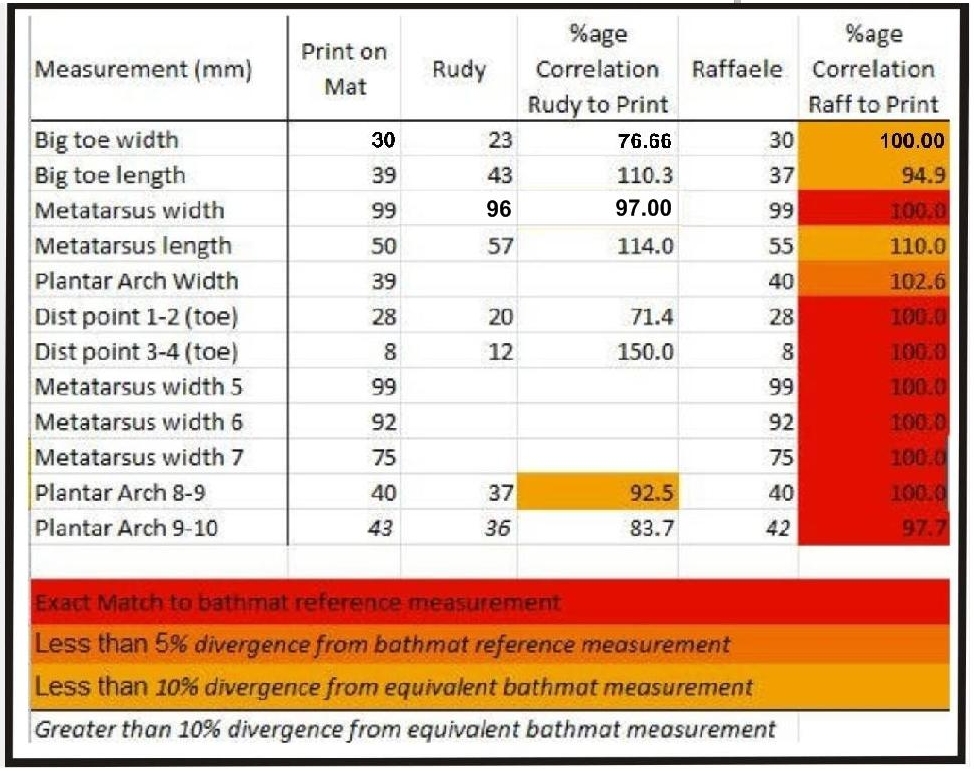
SomeAlibi’s post of a year ago
Comparison of measurements and analysis of correspondence degree of bathmat print, with both Guede’s and Sollecito’s sample prints.
Monday, March 03, 2014
As Knox & Sollecito Try To Separate Themselves, Each Is Digging The Other In Deeper
Posted by willsavive
1. Sollecito Blabs Yet Again
One of an increasingly long list of “gotchas” for the prosecution, flowing from their tendencies to talk way, way too much.
In a recent exclusive interview on an Italian TV news broadcast, Sollecito said he has several “unanswered questions” for his former girlfriend, Amanda Knox.
“You all know that the focus was only through Amanda to her behavior, to her peculiar behaviour, but whatever it is, I’m not guilty for it. “Why do they convict me? Why do put me on the corner and say that I’m guilty just because in their minds I have to be guilty because I was her boyfriend. It doesn’t make any sense to me.”
This adds yet another waiver to the many different explanations Sollecito provided over the years about the same details.
In their “official” story, in the part that remained consistent, Knox and Sollecito both claimed that Knox left his flat the morning after Kercher’s murder and returned home, where she noticed the door left wide open and witnessed blood spots in the bathroom.
Knox claimed that she found it odd and just assumed that one of her roommates was menstruating and left blood behind. She proceeded to take a shower and returned to Sollecito’s flat and ate breakfast.
2. Telling Narrative Change
“Certainly I asked her questions,” Sollecito explained in his latest interview. “Why did she take a shower? Why did she spend so much time there?” When asked what responses he had for these question Sollecito replied, “I don’t have answers.”
In the interview, Sollecito said Knox left his apartment to take a shower, then returned hours later looking “very agitated.”
Yet, in an interview with Kate Mansey on 4 November 2007 just two days after the murder, and two days prior to arrest, Sollecito said:
But when she went into the bathroom she saw spots of blood all over the bath and sink. That’s when she started getting really afraid and ran back to my place because she didn’t want to go into the house alone.
3. RS Differs Sharply From Knox
This is a far cry from what Knox said in her email also dated 4 November 2007 to friends and family, Knox wrote:
I returned to raffael’s place. after we had used the mop to clean up the kitchen i told raffael about what i had seen in the house over breakfast. the strange blood in the bathroom, the door wide open, the shit left in the toilet. he suggested i call one of my roommates, so I called filomena.” (6th paragraph).
The discrepancies between Knox’s version and Sollecito’s version is strikingly different.
- Raffele claims Knox was visibly distraught when she returned and that this was the focus of discussion (i.e. being the first thing they discussed).
- Knox claims that she did not even bring up the bizarre circumstances back at her apartment until “after” they finished mopping the kitchen floor.
4. My Analysis Of The Above
In his latest statement, Sollecito is clearly trying to distance himself from Knox, believing that there is far more evidence against her than against him. But:
- Sollecito forgets to mention the bloody barefoot prints at Knox’s apartment, found to be in Kercher’s blood attributed to him.
- Also the knife found in his apartment that scientists say was the murder weapon.
- Also his DNA found on Meredith Kercher’s bra that was found in her room, even though Sollecito claims that he was never ever in that room.
- Also his own strange behavior, which includes providing a false alibi (saying he and Knox were at a party with a friend on the night of the murder).
Also several conflicting other versions.
But what’s there to question if you [Raffaele] were with Knox the whole day and night of Meredith Kercher’s murder?
It appears as though Sollecito is alluding to the notion that he knows something far more than he is saying; yet, he is being very careful with his words””only providing us with a hint of this.
His latest statement is a clear attempt to distance himself from Knox.
5. Sollecito Freaks Out On Twitter
Sollecito appeared on Twitter recently, for what he claimed was to answer questions and clear his name.
He was very outspoken of his innocence and had no problem in his witty, sarcastic responses to those who questioned his innocence.
However, when I asked him about the Mansey interview he denied claiming that he was with Knox at a friend’s party on the night of the murder [huh?!].
Sollecito disappeared for a couple of days, came back to Twitter writing only in Italian, and ceased responding to any more questions.
Is it possible that Sollecito will turn on Knox altogether at some point when the pressure mounts over the next year? Guess we’ll have to wait and see”¦
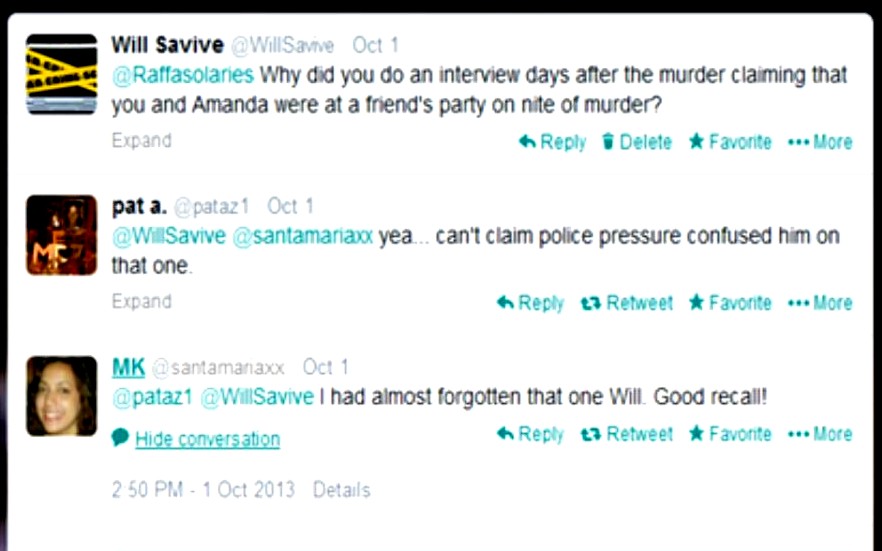
Cross-posted from Savive’s Corner
Wednesday, February 19, 2014
Our Reviews Of The Painstaking BBC-3 Report First Aired In The UK On 17 February 2014
Posted by Our Main Posters
Review by SomeAlibi
Watching “Is Amanda Knox Guilty” was a funny thing. I suspect for people following the case closely, on either side, it was a sobering experience. Not because it changed perspectives, but simply to see how quickly one hour passed and the necessary trade offs that had to be made to fit within that schedule. The opportunity cost was a level of detail to which in-depth followers have become accustomed.
Just one example: Sollecito and Knox’s partial alibi that they were checking their emails on the night of November 1st was explained as being challenged by two broken computers. Perhaps, (although unlikely to be the material issue) but where was the much more salient fact that their ISP records showed that was conclusively untrue? Where was the challenge: if you say you’re checking emails to establish part of your alibi against a murder and it is shown to be absolutely untrue, what does that suggest…?
There were many other “clinchers” that had to be let go in the name of brevity. But it wasn’t that sort of documentary - it was neither a case for the prosecution or a case for the defence: it put the main suggestions at the level of detail that was possible and it allowed both sides to speak to the points at that level of detail.
I find it interesting that there has been such a howl of bias from those supporting Knox and Sollecito. Objectively there’s no good ground for it: the documentary allowed both sides forward in equal measure and no pro-justice watcher would celebrate it as a pro-conviction piece.
The arguments were balanced, the video, audio and picture quality eye-opening. For those on the other side, their markedly different reaction appears to be that the documentary has broken the taboo that The Evidence Shall Not be Told. The idea that there is an easy-to-consume piece that puts forth the case and defence equally is seen as a disaster.
The campaign for Knox continues to be obsessed, beyond all things, with trying but now failing to make sure the public doesn’t know the basis of the case. For a long time they hoped to drown out the multitude of terribly inconvenient truths within it by screaming “no evidence”. ‘Is Amanda Knox Guilty’ put the lie to that conclusively, but fairly, and now many hundreds of thousands, perhaps soon to be millions will ask themselves why those supporting Knox and Sollecito have had to adopt this tactic at all.
If they really are innocent, why has the case against them been so comprehensively white-washed in the US?
The conclusion, is rather simple and I saw it encapsulated on a large television screen last night with the repeated clips of Amanda Knox and Raffaele Sollecito outside the cottage kissing and “comforting” each other: there for a fraction of a second, shown several times, is Amanda Knox, unable to stop herself glancing at the camera filming her and stealing her gaze away again very quickly pretending she hasn’t.
It’s a look that says everything: furtive, pretending it didn’t happen, immediately covering up in a way that poses a stark proposition: why on earth would you do that if you had nothing to hide? And like so much of the multiple collapsing alibis and non-working answers and the desperately dishonest fingers-in-the-ear “no-evidence” pretence of those supporting her, is a proposition that can withstand no scrutiny.
Review by SeekingUnderstanding
What a relief to watch a very clear and unbiased narrative. The quality of the visual information was top rate - seeing so much original footage, and presented as it was in a logical time sequence.
Even though I was already familiar with the evidence, including the photographic material, I found it very helpful to see it all presented in this way. I appreciated, too, hearing and seeing the excerpts in original Italian (along with English translations). It added even more authenticity.
I hope that, at long last, this will have helped some - or hopefully many- people to see that the two ‘camps’ in this case do not divide into AK supporters and AK ‘haters’. There are the FoA and their followers ...and there are the others who seek the objective truth and justice.
If hate has been generated in some quarters, then the Knox (and Sollecito) camps need to look to themselves and their own behaviour. This programme was important in the tone it set.
I actually found it to be quite lenient towards the defence on a number of counts.
There were several instances where the defence point of view could have been strongly countered by known and established facts, but, bending over in fairness, these were left unanswered.
Here are just four instances :
1) In the discussion around the blood and DNA left in the bathroom - Dr. Gino’s assertion that ‘the blood/DNA ‘could have come from anywhere’ might have been countered with AK’s own declaration that the bathroom was previously clean. Dr. Gino also suggested a very improbable scenario of ‘it could be saliva’ (on the bidet?). Cassation emphatically said that it must be shown HOW any suggested contamination could have occurred.
2) There was a missed opportunity in discussing the knife presumed to be the murder weapon to mention Sollecito’s lame, unreal excuse of ‘Meredith pricked her hand’ etc.
3) Anne Bremner stated ‘Amanda could not have turned overnight…into a murderer’. Attention could have been drawn to many things, both physical events (her predilection for cruel pranks, including a staged burglary in the US, and wild parties, etc), and also many psychological indicators that would have clearly shown how her behaviour has, in fact, demonstrated consistency.
4) In the discussion re the bra clasp, the delay partially being caused by the defence themselves was not mentioned. Also, detailed discussion re the one bare footprint on the bathmat was omitted.
Since there is, in fact, so much evidence, it must have been difficult to chose and balance what did go into the hour long programme. All in all, I feel Andrea Vogt and her team worked hard, and did very well to let the facts speak for themselves.
I hope it will lay a few fictions and myths to rest.
Review by Earthling
What is the “Amanda Knox trial” (really the Meredith Kercher murder trial) really about? Is it about an innocent 20-year-old pretty white girl being railroaded by the medieval Italian justice system?
Or is this actually a murder trial, about the fact that a beautiful, intelligent, ambitious young woman, innocently trying to improve her life by study abroad, was brutally murdered?
I believe it’s the latter, and the BBC3 production gives us one of the first truly balanced reports on this trial.
The filmmaker starts from the beginning, and takes us through the murder, investigation, and various trials and appeals up to the present day. Instead of the breathless “Perils of Penelope” tone (toward Amanda Knox) that most such previous “documentaries” have taken, this one takes a sober look at the actual evidence.
Did you realize that there are luminol-revealed bare footprints in Knox’s size in the apartment? Luminol reveals blood and a few other substances; but those substances can be ruled out because the test was done six weeks after the murder, by which time those substances would have dissipated.
Blood doesn’t dissipate. This documentary shows you those bloody footprints in all their creepy glory, something never shown on American TV before.
“Is Amanda Knox Guilty” also speaks of the actual DNA evidence in the cottage linking Knox to the murder, including five mixed-DNA spots (Knox and Kercher) that tested positive for blood. Both prosecution- and defense-oriented experts are allowed to comment on this evidence, and the viewer is allowed to make up his or her own mind.
My one criticism is that a lot of the evidence against Knox (witness statements, cell phone data, fake break-in) is skimmed over or not even mentioned. Also, because the documentary quotes Rudy Guede’s position at length without any contradictory narrative, it is confusing as to whether the filmmaker might have believed him.
In the end, the filmmaker says, he was convicted of participating in the group murder. However, a stronger statement against his “I’m entirely innocent” defense would have been good.
Other than these quibbles, this is the best documentary on the Meredith Kercher murder case that I have ever seen.
Review by ZiaK
I watched the BBC programme on the Meredith Kercher case hoping for a more balanced view of the case than has been presented in the English-speaking media to date.
The documentary does present some of the evidence against Knox and Sollecito - including the bloody footprints, the mixed blood/DNA traces in the bathroom and corridor, the bra clasp, the knife DNA evidence, the strange timings of phone calls to police, the unlikelihood of the “break-in” being anything other than staged - but omits to point out that none of the other flatmates’ DNA was found in the blood traces, so saying that “it’s because Meredith and Amanda shared a flat” is misleading.
Nor does it point out that, although the murder knife was found in Sollecito’s flat, none of HIS DNA was found on it: it had only Amanda’s and Meredith’s DNA.
The programme didn’t cover the cell-phone evidence, showing that neither Knox nor Sollecito were where they said they were, at the times that they claimed. The programme also repeated the “Friends of Amanda” PR soundbites, such as “there was no evidence of Amanda in the murder room” - whereas the fact that her footsteps tracked blood OUT of the room are actually evidence of her having been present IN the room before it was locked (i.e. at the time of the murder).
Furthermore, in my opinion, the narrator’s voice seemed to evince sympathy towards Amanda, rather than describing events with a passive or objective tone of voice.
As one of the translators who has participated in translating case documents (such as the judges’ reports describing why they came to their decisions), I am only too aware of the extent of evidence against Knox and Sollecito, and I would like to see knowledge of this evidence become more widespread throughout the English-speaking world.
The BBC programme is a step towards this, but in my mind, only a very small step. I hope the pace will pick up soon, and more objective and extensive knowledge of the true facts of this case will be made available to everyone so they can form a rational opinion of the case based on true understanding.
Review by Cynthia
I’ve just watched this, and it’s very good - with a huge amount of footage hitherto unseen (directed by Andrea Vogt).
For what it’s worth, I note the following points:
1) There’s no mention of Meredith’s friends who heard Amanda say ‘she fucking bled to death’ before the fact was known to anyone else. Perhaps they didn’t testify, being too distressed? If so, it’s a great pity, because it seems a veritable clincher that hasn’t been used at all.
2) The bra DNA arguments are quite extraordinary. If we can determine that we all have Neanderthal DNA (tho’ I know a lot of American fundamentalists don’t believe that mankind goes back more than 6,000 years!) I can’t for the life of me see why DNA would be unusable after a poxy delay of 12 days ...
3) The argument that the Luminol traces may indicate not barefoot treading in blood but in bleach seems absolutely unbelievable to anyone who does housework (like me!) Bleach is horrible stuff, and you really, really don’t want to be getting it on your bare skin. Even Amanda, with her vestigial domestic skills, would have noticed if she’d trodden in it.
4) Bremner says Amanda was an honor student. She wasn’t; she had funded herself (not that that’s discreditable). (Also, are honor students unable to write cursive script? The shots of her handwriting show that she can’t do joined-up writing. [Or thinking.] I don’t know whether the phrase exists in American English, but not doing joined-up writing is a term of great intellectual contempt in English.)
5) We saw Amanda’s ‘mask’ speech. This is really interesting - who would even think that masks were being put on them if they weren’t using them themselves?
6) The programme mentions the little-reported fact that another, smaller knife found at Sollecito’s also had Meredith’s DNA on it.
7) The film omits to mention Hellman’s lack of any experience in criminal trials.
8) Every shot of Amanda in the film has her talking about ‘me’ and ‘I’. She never, ever mentions Meredith - it’s all about HER suffering. She never even says ‘the murderer is out there - I wish you’d stop persecuting me and get them’.
Presumably this is because Guede is supposed to be the sole murderer - and nobody seems in the slightest bit worried that there’s no murder weapon with HIS DNA on it! (Yes, there are his turds - but that wasn’t what killed Meredith.)
9) FOA has used the fact that the recent jury took 12 hours to deliberate over the verdict as an indication that they couldn’t agree. But why not just that they were being extremely careful and re-examining everything?
10) Finally, just an observation: Maresca speaks the most beautiful Italian - you can hear every word calmly flowing past.
Review by Miriam
Much appreciated. Outside of the Porta a Porta transmissions on the case, the best I’ve seen.
I understand they had to give both sides, but I felt that the defense came out on the losing side. I thought it funny that it was implied that since they only tested for blood it could of been saliva.
I don’t believe even her supporters would argue that Knox was so quirky as to brush her teeth in the bidet! Or maybe she spit in the bidet, in which case Meredith would have had every reason to complain about her bathroom habits!
Now if only this or something like this would air in the U.S.
Review by Sara
This is actually one of the most objective and well-researched reports I have seen on the case and I am very happy that BBC has managed to be so unbiased.
It presents both sides of the story equally well and does an excellent job of countering the extremely silly “no evidence” argument that the FOAkers like to repeat at equal intervals.
Regardless of what one believes, I think the documentary will at least succeed in convincing most people that there is indeed sufficient evidence against the two of them, and Italy’s judicial system is not crazy to convict people without any evidence.
My favourite part was when the defense DNA expert (can’t recall her name) tried to explain away the mixed blood evidence by saying that one of them could have had a nose bleed, and the other could have cut her hand in the same place leading to mixed blood.
Come on already, what are we? Kindergartens making excuses for not handing in homework? What is the possibility that both of them would bleed in exactly the same places not once or twice but multiple times? I think anyone with a bit of sense can see that they are clutching at straws.
However, I was a bit disappointed that few things were missed out. For instance, the fact that Guede’s footprints led straight out of the house, the fact that Amanda’s lamp was found without any obvious reason in Meredith’s room, Amanda’s extremely odd midnight call to her mom that she conveniently “forgot”, her million showers despite her concern towards “water conservation” etc.
Sollecito’s multiple changing stories were not really elaborated upon (the story in which he went to a party, the one in which he checked emails, the one in which he pricked Meredith etc etc).
Also, inconsistencies between their accounts of various events could have been pointed out (Was Filomena’s door open or close? Did AK call Filomena from the cottage or from Sollecito’s house? etc).
Witness accounts were not given any screen space either. I think touching upon these would have made the documentary even more impressive.
That said, I understand that the team has done the best they would within the limited time they had, and everything just cannot be accommodated within one hour.
So, all in all, kudos to the team and BBC for a job well done.
Review by Odysseus
I though it was a very competent overview of the case. After so much pro-defendant spin in the MSM (no doubt engineered by the American defendant’s PR outfit), it was refreshing to have a sane, measured and rational presentation. The victim deserves no less.
Congratulations to BBC3 and to the programme makers. It’s good to know that the BBC of blessed memory hasn’t been entirely dumbed-down nor intimidated by “partial outside interests”, the latter being director Andrea Vogt’s own description of the forces intent on muddying the waters in this case.
Tuesday, February 18, 2014
Congratulations To The BBC For A Report Emphasizing The Sheer Extensiveness Of The Evidence
Posted by Our Main Posters
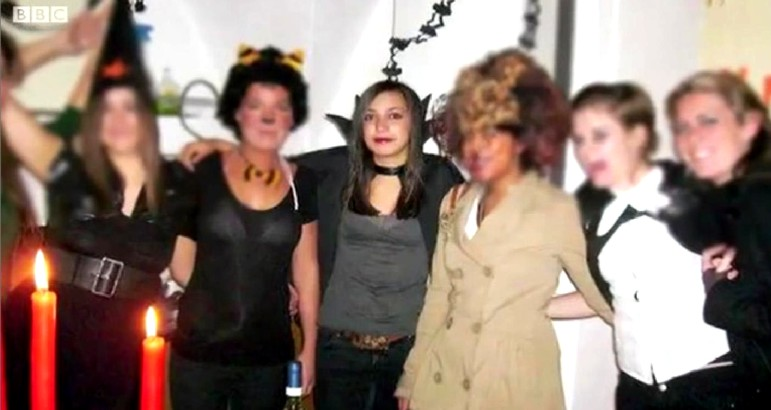
[From the BBC report: Meredith the night before the cruel, deadly attack with her Halloween friends]
This is the painstaking and obviously expensive report by Andrea Vogt and Paul Russell with interviews in London, Seattle and Perugia.
It was aired by the BBC on 17 February. Considerable time is allocated to defense lawyers and experts and the Knox family and Ann Bremner of the FOA taking their best shots at explaining how Knox could maybe have not been involved.
Still, the sheer mass of the evidence remains as the 80,000 pound elephant in the room, lacking any hint of a realistic alternative explanation. Three people committed the horrific attack, including Rudy Guede and two others.
Only Knox and Sollecito remain pointed to by dozens of evidence points as those two others. Not one single evidence point indicates anyone else was involved. The Masssei trial court got it right as the Nencini appeal court just confirmed.
We will enquire if we can embed the hour-long video. But as it may be picked up by US and other foreign media outlets, we will start by simply summarizing it soon. Assessents by those who have already seen it are welcomed.
Monday, January 27, 2014
An Investigation Into The Large Knife Provides Further Proof That This Was THE Knife
Posted by Ergon
Overview
This is the first report of an investigation (the second part follows soon) of the kitchen knife used in the murder of Meredith Kercher, RIP.
Specifically its compatibility with the imprint of a bloody knife found by police investigators on her bed under-sheet which as you will see here seems possible to prove.
Two other recent posts also concentrated on aspects of the knife as strong proof: (1) proof of both Knox and Kercher DNA and (2) proof from the throat wounds.
- Reference files are from very high definition crime scene photos not in general circulation.
- Grateful thanks to the volunteers of the Meredith Kercher community who assisted in this production
Florence Court of Appeals
This is our poster Machiavelli, tweeting from the Florence courtroom on November 26, 2013:
“(Prosecutor Alessandro) Crini stated that this kitchen knife was compatible with the knife print on Meredith’s bed sheet”.
And this is from the defense summing up on January 09, 2014:
Bongiorno: “It’s too big, not the murder weapon.”
“Bongiorno shows a picture with an envisioned “knife” (pocket knife belonging to Guede?) together with the print on the bed sheet.”
“Nobody brings a “small blow with a big knife” “You don’t use half of a big knife” (she says)
Genesis of an investigation:
To recap: evidence was been presented at the Massei court of the first instance, which accepted that the kitchen knife, containing both Meredith Kercher’s DNA on the blade (trace B) and Amanda Knox’s DNA on the handle (trace A) was the weapon that struck the fatal blow to Meredith Kercher’s throat.
At some point after the attack, the perpetrator, Amanda Knox, puts it down on the bed, leaving “hematic stains” (bloody imprints) on the mattress.
The court concludes the shape of the imprints are compatible with the kitchen knife. It also concludes, based on the size of a lesser wound that a second, smaller knife caused the wound on the other side of the neck, and, the impossibility of accepting that a single weapon inflicted both wounds.
This is what it boils down to now, as we come to the final arguments of this case on January 30, with a decision to be handed down by the court later in the day:
- Was the kitchen knife found in Raffaele Sollecito’s kitchen the murder weapon that killed Meredith Kercher on November 01, 2007?
- Did the killer leave behind proof in the form of bloody imprints on the under sheet covering Meredith’s bed?
- And is the defense trying to divert attention away from it, even though the image on the bed fits the dimensions of the kitchen knife?
- And pointing to a second knife, not ever found?
This article (to be followed by part II) was prepared to offer answers to these questions.
Methods used
As someone with a keen interest in photography, I know we see things in photographs that are not always apparent to the naked eye.
Where before we had all been misled by low definition photographs released by the defense to obscure incriminating details, I was able to obtain and view the high definition photographs shown here that proved that indeed, the bed imprints matched the seized kitchen knife, exhibit 36.
These photographs, first posted at Perugia Murder File Evidence Files have been circulating for some time, with members trying to match the knife to the bed imprints, but not, in my opinion, being able to match it exactly.
First, note that the killer placed a knife on two separate locations on the bed, marked by reference cards “J”, and “O”. (Reference photos below.)
I discarded “J”, because there was too much blood there to form an accurate measurement. The killer lifted the knife and then placed it at “O”, which gave a better image, but even then, did not match exactly. Still, it was clear the images looked like a kitchen, and not, a pocket knife as alleged by the defense.
Looking at the reference photo, I saw a double image of a knife blade at “O”. (see where there’s a curved edge of the blade? That’s what convinced me there might be a double image there)
Conclusion reached
My opinion is the knife shifted slightly when it was placed there, hence the double image, which now made a perfect match with the kitchen knife, in both instances (see reference photos).
So I got a professional illustrator and other skilled people people to do the scale drawings and produce the video you see above which seems to provide conclusive proof the murder knife was placed on the bed.
Reference photos:
Image 1 above (click for larger image): Bed II (Image J and O on under sheet, shot November 02, 2007)
Image 2 above (click for larger image): Knife II (Image O on under sheet, shot November 02, 2007)
Image 3 above (click for larger image): FOTO5BIS (Conti-Vecchiotti lab, Mar. 22, 2011)
Image 4 above (click for larger image): Knife-Bed-Vector-AllScales (To prove the scales used to match the images)
Image 5 above (click for larger image): Knife-pos-lower-hi (The knife’s first resting position at “O”)
Image 6 above (click for larger image): Knife-pos-upper-hi (The knife’s final resting position at “O”)
Next steps
There are only four more days left till the Florence Appeals Court under Judge Nencini issues its verdict. It must of course consider ALL the evidence, of which there is a preponderance that indeed suggests the verdict will, as would be proper, be guilty as charged.
Part II will be ready ASAP. It will be a recap of Massei on the knife, and how the defense continually tried to divert us away from the knife image by saying it did not fit the dimensions of the major wound. Also will have Frank Sfarzo’s misdirection and Bruce Fischer’s amateurish attempts to prove that Rudy Guede caused the knife wounds.
Happy as always to do my share for justice for Meredith Kercher.
Saturday, January 18, 2014
False Claims In Bongiorno’s Summation: That The Wound “Proved” Sollecito’s Big Knife Was Not The One
Posted by Our Main Posters
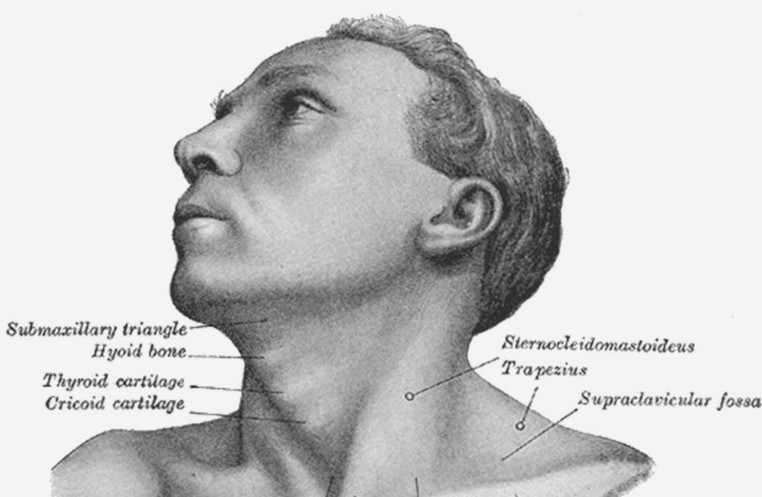
In defense summation on 9 January, nobody who really knows the case (such as Judge Nencini) would have bought many of Giulia Bongiorno’s outlandish arguments.
The post below this one illustrates how Bongiorno in about half her arguments tried to demonize and mischaracterize all of Perugia, as if somehow Perugia itself had become the real villain in forcing a rush to judgment and wrong conclusion. In fact Perugia took a huge hit from Meredith’s murder but has acted gracefully and competently ever since.
This post by several of us after discussion in Comments is the first of two on Bongiorno’s claims about the large knife. The second one will follow next week by Ergon.
There is no question in our minds but that this IS the murder weapon. It was proved convincingly by way of the DNA tests done by the Scientific Police and Carabinieri. Here we prove it by way of human physiology and the autopsy.
Waving two knives with a manic expression, Bongiorno claimed that the the large knife in evidence was far too large for the wound in question - and anyway, anyone intent on murder would have easily pushed the large knife right through so there was no intent of murder anyway. Bongiorno dismissed the possibility that hyoid bone could have somehow stopped the blade, prevented it from penetrating, as the bone is not resistant enough.
The surface location of the hyoid Bone is shown in the Illustration above; its front is only a few millimeters below the skin: The hyoid bone is loop-shaped like a C, open at the back; this Hyoid loop encloses part of the airway:
The hyoid bone curves around the upper airway at the base of the tongue, and is also called the tongue-bone or the lingual-bone. It is located between the mouth and the larynx; therefore during inhalation air passes through the hyoid loop before it passes through the larynx, and during exhalation air passes through the larynx before it passes through the hyoid loop.
The hyoid is an integral factor in the swallowing, breathing, and phonation mechanisms. If transected in such a way as to connect its part of the airway directly to the atmosphere, as it was in this case, swallowing, breathing, and phonation will be seriously impaired, as they were in this case.
The coexistent bleeding from the also-transected Right Superior Thyroid Artery accelerated Meredith’s death, more by the drowning-effect of inhalation of the blood into her lungs, than by the loss of circulating-blood alone.
Both the hyoid bone and the jawbone are mobile, which is why we can chew, swallow, talk, smile laugh, and sing, the way that we do, each of us in our own unique way.
The Massei Prosecution Reconstruction depicted the killers making cuts obliquely from behind.
The fatal cut started on the Left, but crossed the midline to the Right.
Both the Right Superior Thyroid Artery, and the nearby Hyoid Bone, were severed but from Massei, it is not precisely clear where the hyoid loop was severed, and it seems that the cut did not include the midline skin; The Florence Appellate Court will have access to the relevant records.
Here is why the hyoid could not have damaged any knife:
It is an old rule of materials-physics that a softer substance cannot even scratch a harder substance.
[To some people this may be counter to their intuition, so I have passed it by an eminent MIT physicist, and he agrees with me that the knife blade would not show signs of damage caused by the stabbing in this case.]
As pointed-out recently on TJMK, some confusion has arisen, caused by a quotation in the Massei Report, where on p371is written: “”¦a single blow was apparently halted by the jawbone”¦”
The statement that a blow could be “apparently halted” by Meredith’s jawbone is at best a figure of speech, and the quotes of Prof Cingolani on page 152 of the Massei Translation clearly indicate that any cause and effect inference from the phrase “apparently halted by” did not mean it was stopped-by the jawbone:
Prof Cingolani “did not, however, have elements of certainty to establish that the blade which had caused the wound 4 centimetres deep had stopped at the said depth because [it was] stopped by the jawbone.”
Maybe there is a Judicial, translational, or typographical glitch and “by” the jawbone should have been “at” the jawbone.
Skin is soft and bone is harder but there is no way that the knife striking the jawbone would halt the knife in this case, the jaw would just roll with the strike, depending on the angle of attack. [The force was not even enough to mark the jawbone itself!]
Furthermore, contact between the knife and jawbone or hyoid bone would not mark the knife because living-bone is softer than the knife.
When your pet gnaws on a non-living cow-bone, neither the bone nor your pet’s teeth can bend; both your pet’s teeth and the bone can be broken or dislocated, and the bone gets scratches on it because it is still softer than the teeth, but your pet’s teeth do not get scratches on them, because they are harder even than the non-living bone.
If someone is stabbed in the back with a kitchen carving knife, penetrating ribs on its way to the heart, the knife may have no scratches at all, nor show any signs of damage caused by that action.
[Look at your own kitchen carving knife. It probably has no marks caused by striking chicken thigh bones. It will have fine parallel scratches created in the manufacturing process.]
Any implication-in, or inference-from the statement quoted above that stabbing Meredith’s neck with enough force to penetrate the layers of her neck and then strike bone would have the effect of signs of damage to the knife-blade is a figment of an uninformed imagination.
The kitchen-knife, found in Sollecito’s apartment, with Meredith’s DNA on the blade and Knox’s DNA on the handle, is the weapon that killed Meredith.
Thursday, January 09, 2014
Appeal Session #8: Sollecito Attorneys Today Try To Show Where Police And Prosecution Went Wrong
Posted by Our Main Posters
[Giulia Bongiorno today; previously she collapsed in court after a guilty verdict in PM Andreotti’s case]
4. Tweets by Main Poster Machiavelli
148. Bongiorno relies on her “personal belief” as last argument. Bye bye!
147. Bongiorno offers the known arguments to maintain an early time of death. But (now) it’s late for me.
146. She had opened her arguments by quoting Sardinian judge and author Salvatore Satta, to me the choice suggest setting a desperate defence
145. Bongiorno built and waded through a complex building of argument employing extreme rhetoric devices, seemed to be in difficulty to me.
144. I had the impression Nencini was skeptical because not interested in the photos and videos, did not look at them attentively.
143. Details the “plausibility” of an intrusion through the window. Glass shards etc. arguments already seen.
142. “Cogne” is a famous Supreme Court ruling saying guilt can be found “by logical exclusion” on sheer “a contrario” arguments.
141. After brandishing two knifes before the court, talking about footprint, makes an emphatic comment “We are not in Cogne”
140. Bongiorno has ended the ninja-knife-rotating phase.
139. Now Bongiorno speaks about the bathmat bloody print. Says Sollecito’s big toes do not balance on the dystal phalanx. (old argument)
138. Bongiorno shows a picture with an envisioned “knife” (pocket knife belonging to Guede?) together with the print on the bed sheet
137. Nobody brings a “small blow with a big knife”.
136. Says: to paint a large wall you need a “great” (big) brush (paraphrase of a pun from old advertisement) but you don’t use half of a big knife
135. Bongiorno handles a big knife!
134. My opinion: just behind the hyoid bone base there is the cervical vertebra, very resistant, it was the vertebra that offered resistence.
133. When there is a will to kill, the blade penetrates entirely.
132. Bongiorno dismisses the possibility that hyoid bone could have somehow stopped the blade, prevent from penetrating, it’s not resistant enough
131. cites the report by Dr. Umani Ronchi, saying the knife is compatible, but the blade was not used entirely.
130. Last point about the knife is the kind of blade: 17 cm long, while the wound is 8 cm deep. It’s too big, not the murder weapon.
129. Says there isn’t a note indicating a quantifying was done.
128. B: alleges “many mysteries” about Stefanoni’s report. Says there is no DNA amount.
127. In Stefanoni’s report it looks like as if for all knife DNA traces RealTime had been used; and it’s not true. SAL say Fluorimeter used
126. Another point: Fluorimeter. Stefanoni said the PCR method would have been better.
125. Question how he could deduce the knife was compatible. Bongiorno’s points seem extremely weak.
124. Bongiorno attacks on Finzi’s word: quotes testimony when says “It’s the first knife I noticed” and “seemed compatible with wounds”.
123. Question is: possible that Sollecito kills and then puts the knife back in the drawer again? and that he uses a knife from his own kitchen?
122. How is it possible to touch the clasp, but not the rest of the bra? Then Bongiorno says, now let’s deal with the knife.
121. B: There are two questions: 1. why no traces of Knox and Sollecito (except the clasp); 2. why Sollecito’s DNA on clasp but not on bra?
120. No trace of Knox, how could they clean only their own traces…. etc
119. Attributes to Guede the “rest of the whole bra” plus the purse and sweater traces.
118. Emphasizes that other objects in the room instead are “stuffed with” traces of Guede
117. Also, there is the Y chromosome sequence but says it is not reliable for the same reasons.
116. Mentions further reasons for criticism: 1 low template DNA 2 no second amplification (maybe confuses with knife) 3 unknown biological origin
115. Talks about the expert claiming the DNA profile could be compatible with herself (actually wrong, the expert was a female had no Y profile)
114. Says they “found Sollecito’s profile among a 4- individuals mixed trace”.
113. Says Stefanoni applied a suspect-cantered interpretation method on a mixed trace with multiple possibilities. Old argument, weak.
112. The profiles mixed in the trace are more than two, thus DNA not usable. This point of arguments perceived as weak in room.
111. Says the bra clasp trace is a mixed trace.
110. Says mixed DNA profiles are like overlapping of spider webs. High probability of mistake which thread belongs to which one
109. Bongiorno bashes “inconsistence” of Stefanoni and maintains she mistook stutters for alleles.
108. Says if we apply Stefanoni’s criteria to her own findings, the clasp X trace is not attributable to Sollecito
107. Points out the C&V report where they object how Stefanoni considered the peaks departing from guidelines. Say C&V analyzed each peak.
106. Asks, rhetorically, about the way how Stefanoni read the DNA profiles.
105. Mentions the presence of other DNA contributors on the bra clasp.
104. The usual magnified photo showing the dirt on police glove.
103. Calls these “touchings within a contaminated environment”.
102. Says clasp fabric was touched 14 times with one glove, then touched by other gloves.
101. Says the clasp was moved, found under the carpet, originally was under the pillow.
100. B. shows pictures about the object moved around in the room, carpet under table, cloths on bed etc.
99. Complains about the searches made by Napoleoni’s team on Nov 6 & 7 and objects Prosecutor Crini is wrong when says there was only one collection.
98. Says the bra clasp has a “materialization” on the night of Nov. 3 but was not collected because they forgot to place a tag letter.
97. Emphasizes that the forgotten bra clasp has become the pivotal piece of evidence against Sollecito.
96. Says about 20 people have manipulated objects on the crime scene.
95. Emphatically lists the names of all officers who entered the house.
94. Calls the DNA collection “mother of all mistakes” in this case.
93. Items should be touched only once. Stefanoni told the police to not move the items.
92. Disposable gloves must be used, new ones for each item. Quotes Intini saying impossible avoid contamination of crime scene.
91. Says the collection of DNA is fundamental. The collection must be early.
90. Says Cassazione didn’t read the C&V report carefully. Says not all DNA is usable. Stutter peaks should not be considered.
89. Now Bongiorno is talking about DNA.
88. Basically Bongiorno defined evidence against Sollecito as only three points: (1) late call to police (2) knife with Meredith DNA (3) shoe/foot print
87. When B was describing Donnino as a psychic there were people laughing in the room. Her arguments became more effective after the first hour
86. Bongiorno’s series of “half pieces of evidence” seemed like empty rhetoric. The use of video seemed somehow better.
85. The late clock theory is to maintain that Sollecito did not call the 112 after police arrival.
84. The defence theory is the clock was slow, not fast.
83. Bongiorno showed video of alleged Police arrival recorded by parking CCTV, explains defence theory.
82. One thing the SC and PG doesn’t know is about what she calls the “real” timing of Sollecito phone call to 112, as “proven” by defence.
81. One mistake at the Guede trial was about the shoe print attribution.
80. Explains that the subsequent trials of Guede got many facts wrong because they ignored subsequent development.
79. Said Cassazione did not assess the DNA judge appointed report and that testimonies and defence reports were missing.
78. Bongiorno explained the “reverse funnel effect” by which superior court is unaware about additional findings.
77. Sollecito - said B.- would not intervene to help a guy he didn’t know, and not even to protect Knox whom he had been knowing 9 days
76. If cleaning issues were a casus belli among the girls, why would Sollecito enter a raw to defend Rudy?
75. But B. objected this is still only half a motive, because Sollecito had nothing to do with it.
74. Apparently B. acknowledged Laura Masotho testified about problems with Knox cleaning habits. PG thinks means problems living together
73. Talked about the “second motive” calling it “improper use of toilet”
72. Said Guede was a drop-out, the opposite pro-black prejudice is also unacceptable.
71. Urged the court to not assume as individual is a weak and discriminated subject just because a black man
70. The sex theme party is “surreal” Bongiorno said.
69. Said Knox-Sollecito was a tender relation, they enjoyed romantic kisses, were not bored 50y old seeking hot emotions
68. The motive (sex) for the “festino” (little party) was smartly dropped by the PG
67. The motive “accepted” (by courts) was a sex party, but the PG does not believe it.
66. Said motive was considered almost as an optional; said prosecutor general changed the motive because had no choice.
65. Said that Kokomani was offered 10k euros for his testimony.
64. Bongiorno criticized media trials and said witnesses must be “virgins”, otherwise the Aladdin lamp taints the trial
63. Said the Aladdin lamp effect is generated by media trial, in which a “monster” is chased by public opinion
62. Bongiorno talked about “Aladdin lamp effect”: detectives wishes which materialize.
61. Said Mr. Kokomani “materialized” when investigators had desperate need to prove Sollecito and Guede knew each other
60. Bongiorno talked at length to substantiate a scenario of Rudy as a burglar who was used to knives.
59. Rudi would physically approach girls and try to kiss them when he was drunk, B. Said
58. Said Guede harassed girls and Sollecito did not know him.
57. Said when the investigators found Rudi, they could not abandon the first suspects, because it’s difficult like leaving your first love mate
56. Said there is no evidence the three people hung out together.
55. Spoke about Guede’s alleged lifestyle.
54. Said that was the nightmare of Perugia, the intruder nightmare.
53. Said the room is flooded with evidence of Guede all over the place.
52. Bongiorno criticized factual points addressed by Cassazione, mentions wrong early experts reports.
51. She described Knox as almost unconscious, buckled because she trusted Sollecito, thinks the police and Raff say so, must be true.
50. When Knox learns about bring accused by Sollecito she had a collapse while the “psychic” was saying “remember!”
49. Amanda, B. says, did not understand why Raffaele accused her.
48. Bongiorno urged judges to get out from codes and get into the hearts of the two young accused.
47. Said if you believe to the Memoriale, where does it mention Raffaele?
46. The recording of Knox’s conversation with her mother “proves she was still in delusional state”
45. Bongiorno said even if you believe her confession, she doesn’t mention Sollecito.
44. Said Amanda was “induced into raving” by “psychic” Donnino.
43. Explained the three types of false confessions.
42. Said Knox did not commit a crime but convinced herself she did. B. mentions the internalized false confession type.
41. Talked about police mistake on the “see you later” message
40. Said trial was determined by the fact Donnino fid not understand English well, thus sidetracked Knox
39. But, said, if we look at Knox, it’s not her sidetracking investigation, but rather investigators sidetracking her.
38. Said the Cassazione suggests Raffaele lied about timings of call to carabinieri, accused him of sidetracking because he lied.
37. One of the elements against Sollecito is the accusation of having sidetracked investigation. Said it was false.
36. Called Donnino a “medium” ( means .“psychic”)
35. Said Donnino acted as mediator not interpreter
34. Said Donnino altered Knox’s statements.
33. Bongiorno criticized interpreter Anna Donnino.
32. Sollecito’s aunts wiretapped as if they were the most dangerous murderers.
31. Talking about insults [to Sollecito’s family members], Bongiorno cries.
30. Says they also insulted Knox
29. Amanda was caught by anxious urge to answer. She became uncomfortable because police asked too much, altering her serenity
28. Bongiorno says if the court doesn’t want to read the whole interrogation (of Dec 17) they should at least read the memoriale
27. Nencini interrupts Bongiorno: how could I read all interrogations entirely, when Supreme Court prevents me from doing so?
26. Calunnia doesn’t mean there is evidence of murder.
25. Only half of the house of murder investigated. An interrogation considered evidence of Knox’s calunnia.
24. Says Raffaele was “halfed”, against him only half pieces of circum evidence: half shoeprint’ knife compatible only if you consider half of blade
23. [My] Impression that Bongiorno’s start of defence speech was rather weak. Too much over the top, reveals weakness.
22. shoeprint attributed in advance because boyfriend of Amanda. Speaks about “admission” by Rinaldi-Boemis
21. She is tired of Raffaele reduced by “half”, a half character seen as a reflection of Amanda
20. Says Knox was the main character, she was so before the trial.
19. Speaks about “creativity” before the trial. Speaks at length about the bloody shoeprint.
18. Bongiorno: Raf thinks he was put in jail because of wrong print. But not true: it’s because he was Amanda’s boyfriend.
17. Shows pictures of Vinci’s analysis of pillowcase prints.
16. Bongiorno also said other reason for suspicion was that Knox had the keys. The motive chosen was “ideal” not real.
15. Most active and free women are seen as more suspicious.
14. Bongiorno: women are suspected because of today women’s empowerment movements.
13. Started from a sex party gone awry theory. They asked themselves: who could take part to such party? A 20y American sexy girl.
12. Investigators followed Lombrosian criteria (inspired by Cesar Lombroso theories)
11. Says: it was Perugia population who chose the less disquieting scenario, and the investigation was based on “less alarming motive” choice
10. Bongiorno: authority had to chose between a “tranquillizing” student motive and a dangerous serial killer “worrying” scenario.
9. Why did they accuse and put them in jail so early? They didn’t even have the knife.
8. Complains Sollecito doesn’t find a job because has a murderer’s face
7. Bongiorno focuses on the “early bias” against accused, since four days after finding of body.
6. Bongiorno speech hinges around the persecution of defendants. Describes her fear, fleeing from Perugia. Says people didn’t know trial papers
5. Bongiorno was shocked by the angry mob before Perugia courtroom [after Hellmann verdict]
4. Bongiorno: a bloodthirsty mob chasing defendants
3. Reads book snippet about French revolution, describe a horde of sanculots and armed citizens
2. Bongiorno quotes Italian author Satta. Talks about “chase” of the two accused
1. Sollecito is in courtroom
3. Tweets By Freelance Andrea Vogt
15. Leaving court, raffaele sollecito and father expressed satisfaction w/closing args. Perugia attorny Maori to close at next hearing, Jan.20.
14. Bongiorno closing finish: Turn amanda off. Acquit them both, but judge Raffaele Sollecito for who he is, not for half-truths against him.
13. A loud emergency evacuation request was just broadcast in Florence court, but the presiding judge says hearing will continue.
12. Once you’ve seen Bongiorno wave two knives in front of an Italian jury, most other court reporting one has done seems rather dull.
11. Bongiorno holds up butcher knife like the one in evidence to jury: “This knife is too big. It is not the murder weapon.”
10. New amanda knox court schedule: [prosecution] rebuttals Jan 20, with verdict on Jan 30.
9. Florence amanda knox appeal: court breaks until 14:15. Unclear if sollecito defense will finish today or spill over.
8. Bongiorno: Sollecito is not a puppy dog. He may have brushed her hair, cleaned her ears, but he would not kill for love of amanda knox.
7. Bongiorno and judge exchange laughs over “unca nunca” the eskimo kiss. “I’m over 50,” he said “I need an explainer.”
6. Bongiorno on witnesses found by local journos: “This trial had an Aladdin’s Lamp. Every time cops needed a witness, one materialized.”
5. Bongiorno defending Amanda Knox, while at the same time clearly separating Sollecito’s position from that of Knox.
4. Bongiorno reading amanda’s statement: “If you believe this is a confession, where’s Raffaele? He is never, never, never mentioned.”
3. Bongiorno just read wiretapped comms of Perugia cops Napoleoni and Zugarini insulting Sollecito’s family.
2. Bongiorno: “Amanda amanda amanda amanda amanda . . . And raffaele? Basta with sollecito always being considered Knox’s other half.”
1. Bongiorno: Perugia declared “case closed” 4 days after Kercher murder, w/no murder weapon and a motive intended to calm public fear.
2. Tweets by La Nazione Court Reporter
66. Bongiorno: “In conclusion Amanda and Raffaele are innocent “
65. Bongiorno: “I am convinced that the murderess is Rudy who has already been convicted “
64. Bongiorno “The attack on Meredith takes place at 21.10 when Raffaele ‘s at home “
63. Bongiorno: “Guede had already entered into three more apartments in the holiday periods “
62. Warning to evacuate the court. But it is only a test
61. Bongiorno: “Is it possible that the glass has been broken from the outside “
60. Bongiorno: “The absence of traces of mud on the wall is because in those days it was not raining”
59. Bongiorno: “Plausible hypothesis that someone has entered the window “
58. Bongiorno: “You can not get to a liability via just exclusion . We are not in Cogne “
57. Bongiorno: “Against Sollecito, no real clue “
56. Bongiorno: “The footprint on the rug is not Sollecito, his foot does not match “
55. Bongiorno: “The murder weapon is a boxcutter knife with 8 inches “
54. Bongiorno: “The knife found at Sollecito’s house is not the murder weapon “
53. Bongiorno: “Depth wounds on the victim is not compatible with the size knife “
52. Bongiorno addresses the issue of the knife
51. Bongiorno: “Absurd to think that Amanda and Raffaele have deleted only their tracks
50. Bongiorno: “How can you think that there is only a trace of Sollecito on the clasp ? “
49. Bongiorno: “On the scene of the crime no trace of Amanda, but only Rudy Guede “
48. Bongiorno: “On the hook there are traces of four profiles of DNA “
47. Bongiorno: “That hook looks like it was taken from a landfill “
46. Bongiorno: “The hook was crushed during the inspections “
45. Bongiorno: “The bra clasp was moved “
44. Bongiorno: “The hook of the bra is not at the first inspection reperted “
43. Bongiorno: “About 20 people came to the house between the two surveys
42. Bongiorno: “The finding attributed to Sollecito jumps out only in the second survey “
41. Bongiorno: “It is not true that no one came on the scene between the two surveys “
40. Bongiorno addresses the issue of DNA on the bra clasp of the victim
39. After the break the summation of lawyer Giulia Bongiorno starts again.
38. The hearing is adjourned for an hour
37. Bongiorno ( Sollecito defense ) : ” Rudy Guede did not want to respond to our defense [at Hellmann appeal] “
36. Bongiorno ( Sollecito defense ) : “No survey has ever spoken of the presence of more subjects [than one]”
35. Bongiorno ( Sollecito’s defense ) : “It was Raffaele who raised the alarm”
34. Bongiorno ( Sollecito’s defense ) : “And we demonstrated that Sollicito called 112 before the police arrived “33. Bongiorno ( Sollecito’s defense ) : ” If the motive are disputes on the hygiene of the house, where was Raffaele ? “
32. Bongiorno ( Sollecito’s defense ) : ” The indictment identifies the changes to driving and excessive use of water”
31. Bongiorno ( Sollecito’s defense ) : “the relationship of Amanda with Raffaele was tender, kissed like Eskimos “
30. Bongiorno ( Sollecito’s defense ) : ” Guede unwelcome, if there had been a party he would not have asked “
29. Bongiorno ( Sollecito’s defense ) : ” In this process, the motive is considered an option, but it is not “
28. Bongiorno ( Sollecito’s defense ) : ” Absurd to think that Sollecito and Guede became known that night “
27. Bongiorno ( Sollecito’s defense ) : ” The witness who spoke of the friendship between Raffaele and Rudy Guede was denied “
26. Bongiorno ( Sollecito’s defense ) : ” Amanda Raffaele prosecuted even when they told [the truth?] “
25. Bongiorno ( Sollecito ) : ” Absurd Amanda putting herself at the scene of the crime”
24. Bongiorno ( Sollecito’s defense ) : ” Amanda never pulled into the dance Raffaele “
23. Bongiorno ( Sollecito’s defense ) : ” Amanda wassidetracked , it is she who is derailed “
22. According to the lawyer Bongiorno interpreter on night of interrogation of Amanda did not just translate
21. Bongiorno ( Sollecito’s defense ) : ” The interpreter admiited to having helped in the court”
20. Bongiorno ( Sollecito ) : ” The interpreter confirms that she has done so in trial court as mediums in the interrogation “
19. Bongiorno ( Sollecito ) : ” Amanda says that the interpreter invited her to remember”
18. Bongiorno ( Sollecito ) : “There are black pages in this investigation “
17. Bongiorno ( Sollecito ) : ” According to the documents offenses of aunts of Sollecito by those who listened to the wiretaps “
16. Bongiorno ( Sollecito ) : ” Amanda and nighttime interrogations without a lawyer “
15. Bongiorno ( Sollecito ) : ” The identikit identfication of the killer as Amanda proceded and generates slander “
14. Bongiorno ( Sollecito ) : “On the footprints attributed to Sollecito there was a big mistake “
13, Bongiorno ( Sollecito ) shows some slides in the court on the footprints at the crime scene
12. Bongiorno ( Sollecito ) : ” Raffaele is not the only other half of Amanda . Just a quick passion “
11. Bongiorno ( Sollecito ) : ” Amanda was the stronger of the pair with Sollecito “
10. Bongiorno ( Sollecito ) : ” Amanda was leading [the two] before becoming involved in the legal process”
9. Bongiorno : ” Starting from the motive of the game , Amanda seemed like the perfect one guilty “
8. Bongiorno ( Sollecito ) : ” They have chosen an ideal motive and then followed the criteria Lombroso “
7. Bongiorno ( Sollecito ) : ” A creation was the motive to reduce fear in Perugia , a party gone wrong “
6. Bongiorno ( Sollecito’s defense ) : ” In record time, the case was declared closed almost immediately , after four days ‘
5. Bongiorno ( Sollecito ) : “Against Amanda and Raffaele horde of red herrings”
4. Bongiorno ( Sollecito ) : “Sollecito was branded a murderess when there was no evidence “
3. Bongiorno ( Sollecito ) : ” Raffaele and Amanda have become the symbol of depravity ‘
2. Start of the argument of the lawyer Giulia Bongiorno , Sollecito’s defense
1. Start of the hearing. Today it’s up to the lawyers Raffaele Sollecito
1. Overview post Wednesday by Andrea Vogt
Website of Andrea Vogt
Defense lawyers Giulia Bongiorno and Luca Maori will give closing arguments on behalf of Raffaele Sollecito Thursday in Florence, starting at 10 a.m.While Amanda Knox has been the main focus of attention for most of the U.S. media covering this case, Sollecito has increasingly become the object of gossip in the Italian press, with tabloid magazines like Oggi regularly publishing snaps of him on vacation this winter in Santo Domingo.
More recently several local newspapers in Veneto published speculation about a new woman friend and fellow University of Verona student with whom he had been hanging out with over the holidays in a small town near Treviso. Amore or amica? He’s not about to tell.
At his last spontaneous declaration before the court Sollecito complained about his lack of privacy and pleaded with the jury to give him his life back. Tomorrow his lawyers will make the case for his innocence formally to the judge and jury. Expect fireworks from Bongiorno, famous for her captivating oratory and no stranger to high-profile cases “” having cut her teeth as defense lawyer for former Italian prime minister Giulio Andreotti.
ol
Saturday, December 14, 2013
Why Is Appeal Prosecutor Crini So Very, Very Interested In The Precise Position Of Filomena’s Door?
Posted by Cardiol MD
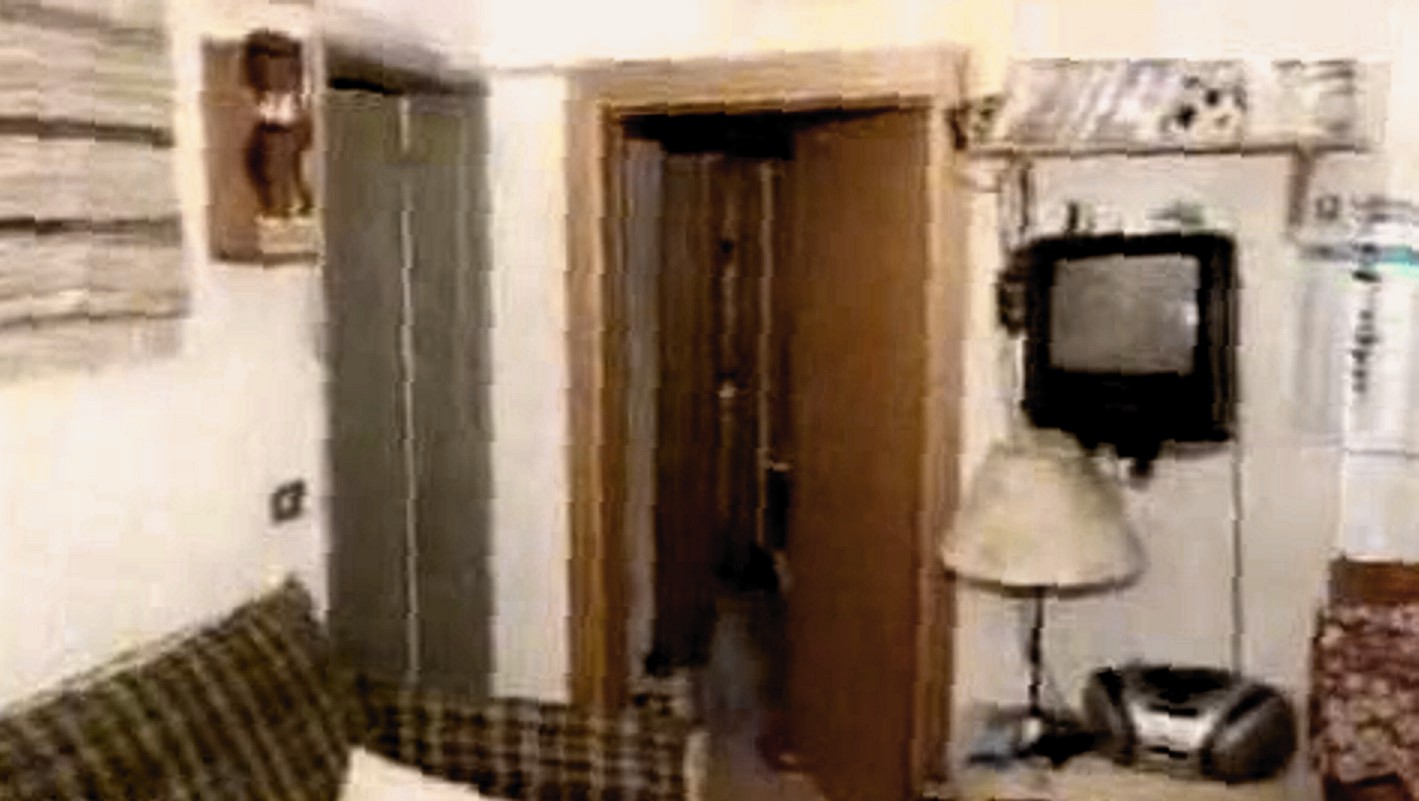
[Above, we can see Filomena’s grey door, at hard left; ahead are Meredith’s & Knox’s bedrooms]
Do please bear in mind that this appeal was initiated by Knox and Sollecito, and the verdict, sentence and sentencing report they dispute is Judge’s Massei’s from the 2009 trial.
The subject of one of Dr Crini’s focuses - whether or not Filomena’s door was open at the various times Knox and Sollecito stated they went to the women’s apartment on the morning-after ““ is a crucial one, relevant to proving Knox’s and Sollecito’s lies and obfuscations.
Wasn’t the staged break-in to Filomena Romanelli’s room glaringly obvious? In the early morning of November 2nd, 2007? In spite of the Knox/Sollecito obfuscations? There is much information in Massei on this question, pointing to many very obvious obfuscations.
Now, for the legal requirements of beyond-reasonable-doubt (BRD) actual, literal quotations are needed. Much relevant information can easily get “˜lost in translation’ not only at the superficial level of paraphrase, as in “They said that”¦..”, but also at the more subtle level of the formats used for quotations.
Some of the Massei Report as translated consists of the actual oral quotations of witness statements, some are quotations of the content of written documents, but some consist only of paraphrases of both oral statements and of written documents.
For some quotations, especially nested-quotations the translation uses various formats, beginning either with a comma or an apostrophe, ending with an apostrophe, and, in my copy, some back-slashes.
This mixture can be confusing to some readers, and Knox and Sollecito are seasoned veterans of exploiting such translational losses. That is a major factor in their continuing obstruction of justice: using chronic obfuscation.
He said, “She yelled, ‘I’m going to kill you.’ “
This quotation-format has been substituted in this post where it seems appropriate. It is hoped that when this format is used only to indicate editorial irony it will be self-evident.
John Follain and Will Savive also make a number of relevant references, and so do some Wiki articles whose authors are too modest to identify themselves though “˜Underhill’ has been mentioned as a co-ordinator.
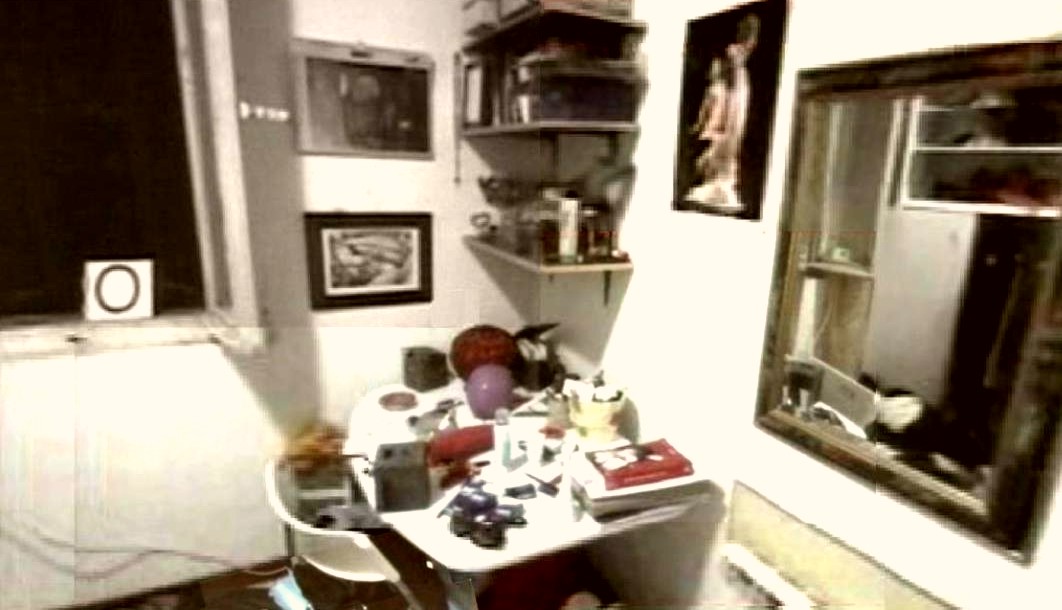
Of course, the members of the Florence Appellate Court have access-to, have probably already read, thousands of pages of evidence, including the actual verbatim witness-transcripts, and that Court will make up its own mind independent of what is written elsewhere.
Here are some of the Massei “˜door’ instances - this is a selection of a relevant 6 out of a grand total of 192 instances:
Massei Page 28: [Amanda Knox and Raffaele Sollecito ““ said that they were waiting for the carabinieri whom they had called since “coming back to the cottage in the morning because they had been away for the night” and finding “the entrance [15] door open and then the window broken” (see declarations by Battistelli, hearing of February 7, 2009, page 64).]
Access to the Court Records would help us better-understand this passage, but Follain (Page 67, Kindle location 939), indicates that Battistelli is actually quoting Sollecito, substituting “˜they’ for “˜we’, so it seems that Sollecito was already obfuscating the facts, encouraging the inference that their shocking observations began only when both he and Knox arrived together and discovered together both the open apartment entrance-door, and from inside Filomena’s room, the broken-window, so we are all being steered away, by Sollecito, from the true answer to our question.
Massei Pages 29-30: [Around midday(Nov, 2nd, 2007), at ten past twelve, when they had not yet arrived at the car park of the Fair, and she(Filomena) was in the car with her friend Paola Grande, she received a phone call: it was Amanda letting her know that there was something strange. She had arrived and had found the door open: she had had a shower and it had seemed to her that there was some blood; moreover she said that she was going [17] to Raffaele’s place (declarations of Romanelli page 31, hearing of February 7, 2009).
To her (Filomena’s) question about where Meredith was, she had answered that she did not know.]
Filomena had apparently not been told by Knox, in this 1st phone-call, about the broken pane, the stone, and the bedroom-disarray, as if Knox was not yet aware of these stunning facts. The obfuscation continues.
Massei Page 30: [Marco Zaroli, who was without a car because Ms. Romanelli had taken it, had called his friend Luca Altieri and they had gone together to the house in Via della Pergola, where they arrived around 1:00 pm, at almost the same time as Filomena Romanelli and Paola Grande. In the house there were the also the two present accused and ““ as we have seen ““ Inspector Battistelli and Assistant Marzi. The presence of the latter two was linked by Ms. Romanelli to what Amanda had told her about the open door, the broken pane, her own room in a mess.]
When Knox first told Ms. Romanelli about her visit, she had omitted reference to Laura’s and Filomena’s doors, whether they were open, whether they were openable, whether Knox opened them, and whether Knox looked inside and saw the broken pane, the stone, and the bedroom-disarray. It is implausible that Knox tried only Meredith’s door and not the others.
It is also implausible that Knox even took a shower at the women’s apartment, colder as it was than Sollecito’s. Amy Frost testified that hours after the body was discovered Amanda Knox told her that she never took the shower, because when she noticed the blood that had stopped her from showering.
The Postal Police commented that Knox also emanated an unpleasant, “˜post-shower’ odour, inconsistent with Amanda having recently had a shower anywhere, implying Knox was lying about taking the shower.
Knox is steering Ms. Romanelli away from these crucial facts which logically demanded that their “˜discoverer’ flee (again), and call the Police. Knox is obfuscating by selective piece-meal feeding-of-the-facts to Filomena.
Massei Page 38: [On the day of November 2, 2007 at police headquarters, Amanda was also there and she said that that night she had been with her boyfriend Raffaele and that the next morning at around 11:00 am she had gone back home to get changed. She had found the entrance door open and this seemed strange to her: she had gone into the house and into her room and she had taken a shower and had seen drops of blood.
She said that after the shower she got dressed and noticed that Meredith’s door was locked. She went into the other bathroom and said that there were faeces in the toilet. Then she went into another room and noticed that the window had been broken and that there was glass inside. She told these things to her and the other girls present. Then she related that she had gone back to Raffaele’s house and had rung Filomena. She remembered that on that occasion at police headquarters Raffaele was very calm, silent.]
When Knox first called Filomena, Knox had omitted any mention of the most significant information - the (staged) break-in, as if she had not ‘noticed’ it.
Now, later, paraphrasing, Massei states: “Then she went into another room and noticed that the window had been broken and that there was glass inside.”
Had Massei not paraphrased, but had written “Then I went into Filomena’s room and ‘noticed’ that her window had been broken and that there was glass inside.”, we could use it as BRD evidence.
The actual, verbatim quote should be among the many thousands of Court Records relied upon by Massei; Nencini’s Court should use such Record in reaching its decision.
Massei Page 65: [Upon returning home, she [Amanda] noticed that the door was wide open. She thought someone had gone to take the trash out or gone to the floor below, closing the door behind them but not locking it. She asked loudly whether anyone was at home, but no one answered. The door to Meredith’s room was closed, and this meant she was sleeping. She undressed in her own room and took a shower in the bathroom, (the one) nearest to (both) her room and to Meredith’s.
When she got out of the shower, she realised that on the little bath mat where she had placed her feet, there was blood and also, there were drops of blood on the sink and the faucet. She left the bathroom and went to get dressed in her own room. Then, she went in the other bathroom to dry her hair, where there was a blow dryer. It was at this time that she noticed feces in the toilet, which surprised her. She then took the mop and returned to Raffaele’s home, locking the door (on the way out.)
She told Raffaele what she had seen and he suggested that she call one of her friends. She then called Filomena Romanelli, who said that she had been out with her boyfriend and that Laura Mezzetti was also away, in Rome with her family. She then realised that the only one to have spent the night in Via della Pergola was Meredith, about whom, however, nothing was known. Filomena seemed worried, so Amanda (Page 66) told her that she would call Meredith, who would then call her back.
She then called the two cellphones that Meredith had, but without getting any response (from her). She then returned home, this time with [55] Raffaele. Upon returning home, she opened the door to Filomena Romanelli’s room and saw that the window was open and completely broken: there was chaos, “šbut her computer was in its place on the desk.”› Convinced that there had been a burglary, she went into the other rooms: Laura’s room was in order, and nothing was missing from her own room.
However, Meredith’s door was closed. She began to knock and to call out, without receiving any answer. She was then seized with panic and went on the balcony to see if she was able to see anything, but she couldn’t see anything. She went down to the apartment below to ask someone, but no one was there. She therefore went back inside and Raffaele said that he wanted to try to break down the door of Meredith’s room, but he wasn’t able to. It was then that they decided to call the police, which is what Raffaele did. She let Filomena know about this, asking her to come home.]
Now, only after returning “home, this time with [55] Raffaele.” does Knox allege that she had then “opened the door to Filomena Romanelli’s room and saw that the window was open and completely broken: there was chaos, “šbut her computer was in its place on the desk.”
Knox continues to obfuscate by selective piece-meal feeding-of-the-facts.
Massei Page 66: [While they were waiting, two police officers arrived (at the scene) and she showed them all that she had seen. Then Filomena arrived with her boyfriend and two other friends, and they broke down the door of Meredith’s room.]
True. There are a number of other Massei references to Filomena’s door and room, but they are basically repetitive of information already in the above references.
This seems to be enough for Nencini’s Court to reach its verdicts re Knox and Sollecito.
[Below: the area from which Knox would have been looking at Filomena’s door]
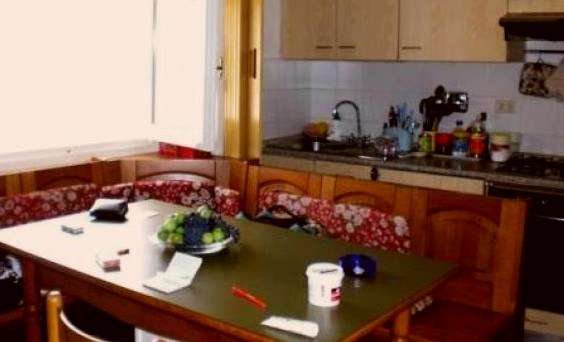
Sunday, November 10, 2013
The Crime-Scene Clean-Up: How Rudy Guede’s Diary Provides Even More Proof That It Happened
Posted by pat az
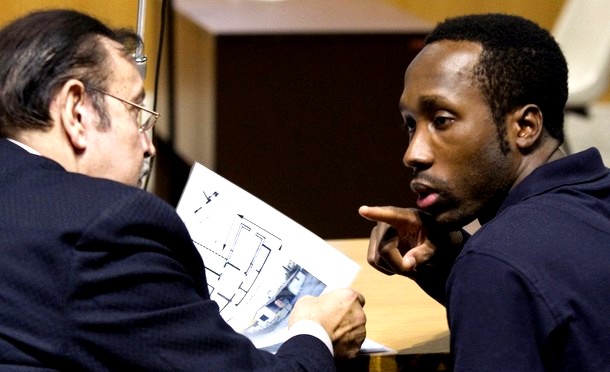
This post is crossposted from my own place. Here is one of my previous crime scene analyses on TJMK.
Rudy Guede was ultimately declared convicted by the Supreme Court in 2010 of participating in the 2007 murder of Meredith Kercher.
The prosecution claims the two other participants are Amanda Knox and Raffaele Sollecito. Knox and Sollecito are currently appealing their conviction of the same crime.
The case against the three of them involves a suspected clean up of the hallway in the apartment after the crime. Meredith’s blood was found in the bathroom, and half a footprint in her blood was found on the bathroom mat. However, there was no visible blood between Meredith’s bedroom and the bathroom.
The only visible blood in the hallway were faint partial shoe prints that led directly out the front door of the apartment.
After the murder was discovered, the media reported almost daily on developments in the case. The day of the murder, the press reported on the blood found in the bathroom and the bedroom.
But until police used luminol at the apartment on December 18th, the media didn’t report on any significant blood found in the hallway. Between November 2nd and December 18th, only one person stated that significant amounts of blood had been in the hallway.
Rudy Guede.
Rudy Guede actually wrote about it in his diary between Nov 20th and Dec 6th, after being captured in Germany.

The police arrived at the apartment on November 2nd. According to media reports, the blood they spotted immediately was only in the bathroom and Meredith’s bedroom. When the scene was more closely examined, after the discovery of the body, police found visible blood patterns on the floor left by Guede’s left shoe as he left the apartment.
None of the people who arrived in the apartment on the afternoon of November 2nd reported seeing them; these footprints are not in any of the stories of the events of Nov 2nd told by Amanda Knox nor Raffaele Sollecito. So, while these prints were visible, they were not substantially obvious.
On December 18th 2007 investigators applied Luminol in the hallway and other bedrooms. This forensic chemical is used to detect blood which has been cleaned away. The Luminol revealed several footprints in the hallway between the bedrooms of Knox and Meredith. Example below. Some of these footprints were leading towards Meredith’s door.
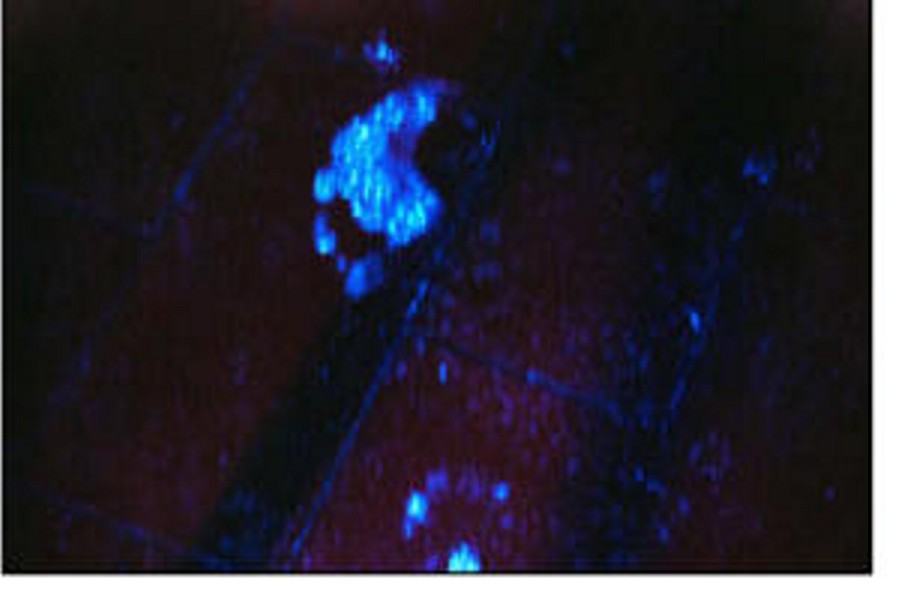
They also discovered prints in Filomena’s room which contained Meredith’s DNA and Amanda Knox’s DNA. They also revealed a footprint in Amanda Knox’s bedroom. (The defense unsuccessfully contested the investigator’s conclusions that these prints were made with blood).
On November 19 2007, an international arrest warrant was issued for Rudy Guede. He was arrested in Germany on November 20th. Guede remained in Germany until his extradition on December 3rd.
During his stay in jail in Germany, Guede wrote a long statement that was published and translated. Guede’s writings are similar to to Knox’s jail writings in many ways - they both try to write out their own detailed version of events, while pointing blame elsewhere.
But Guede’s comments may in fact be confirmation of a clean-up after the murder of Meredith Kercher (emphasis added):
I am asking myself how is it possible that Amanda could have slept in all that mess, and took a shower with all that blood in the bathroom and corridor? (Guede, Germany Diary, P21)
The police did not find evidence of any other blood until December 18th, AFTER Guede returned from Germany. As indicated above, the luminol revealed multiple footprints in the hallway, in Knox’s bedroom, and in Filomena’s bedroom. The image below shows these results in blue. Guede’s partial footprints are shown in red.
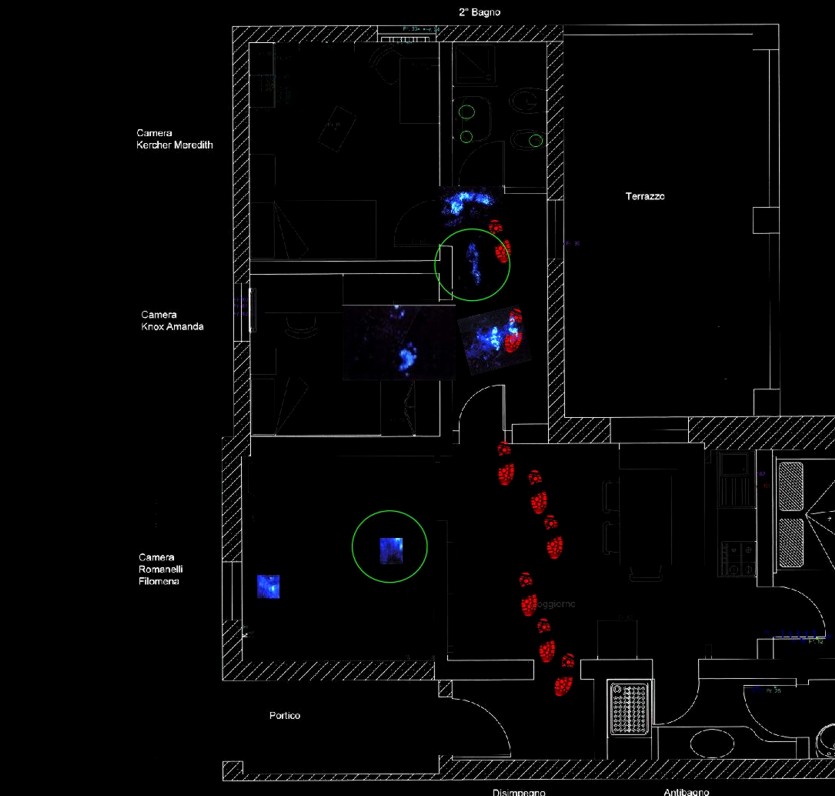
The conclusion is inescapable: Guede knew there would be significant evidence of blood in the hallway, before the police themselves found that evidence.
How did Guede know there would be more blood found in the hallway, before the police found that evidence on December 18th? And why wasn’t that blood there on the morning of November 2nd?
The courts believe the blood in the hallway was cleaned after the murder of Meredith Kercher. And the Micheli and Massei courts believed only one person had the motivation to hide this evidence: Amanda Knox.
Here is a summary of Judge Micheli’s October 2008 indictment finding.
In Judge Massei’s December 2009 trial finding for the original conviction of Knox and Sollecito, he also writes about the clean-up that the judges believed to have happened:
Further confirmation is constituted by the fact that, after Meredith’s murder, it is clear that some traces were definitely eliminated, a cleaning activity was certainly carried out. In fact, the bare foot which, stained with blood, left its footprint on the sky-blue mat in the bathroom, could only have reached that mat by taking steps which should have left other footprints on the floor, also marked out in blood just like (in fact, most likely, with even more [blood], since they were created before the footprint printed on the mat) the one found on the mat itself. Of such other very visible footprints of a bloody bare foot, on the contrary, there is no trace. (Massei, Dec 09; PMF translation)
In defense of Guede, Knox, and Sollecito, some might try to claim that Guede heard about blood in the hallway in the news. Rudy Guede was arrested 18 days following the murder of Meredith Kercher. During that time he had access to read the news and watch reports.
I have searched for articles in the period between November 2nd and December 18 which mention blood. All of the articles I have found so far discuss blood in the bedroom or the bathroom. One or two discuss footprints leading to the front door.
None of them discuss blood in the hallway that would justify a statement from Guede of “tutto quel sangue nel bagno e sul corridoghe” (all that blood in the bathroom and in the corridor)
Guede himself said he went between the bedroom and the bathroom, so may have tracked blood into the bathroom and therefore known blood would be found in the hallway.
Even that knowledge however confirms a clean-up, as there was not a trail of blood between the bathroom and Meredith’s room that justifies the footprint on the bathmat and blood found in the bathroom.
I have my own questions as a result of Guede’s knowledge of blood in the hallway:
Could the attack have started in the hallway? Could the first blood shed have been on the hallway tiles?
The prosecution and courts argue that Amanda Knox had a role in the attack and murder. Knox and her supporters are very adamant that there is no trace of Knox in Meredith’s bedroom. While the courts argue otherwise, could Knox’s role have been limited to the hallway?
Sadly, we may never know the full truth of what happened on the evening of November 1st, 2007.
My timeline of media reports on blood
- Nov 2nd: Meredith Kercher found. Blood found in bathroom.
- Nov 5th: Police analyzing traces of blood from apartment below.
- Nov 5th: A “trail of blood” is on the inside handle of the door to the apartment.
- Nov 7th: reports of Amanda Knox’s statements, includes finding blood in the bathroom.
- Nov 14th: Police use of Luminol at Sollectio’s house. First reports on the knife seized by police from Sollecito’s house.
- Nov 19th: Analysis of blood in bedroom (pillow, bra, etc).
- Nov 22nd: Guede’s prints in blood.
- Nov 27th: Amanda Knox’s blood on bathroom tap.
- Nov 28th: Blood in bathroom.
- Dec 5th: Reports of Guede’s letter to father: “there was so much blood”.
My timeline of main events involving Guede
- Nov 2nd, 2am ““ 4:30 am: Guede seen by witnesses at Domus nightclub.
- Nov 3: Guede leaves Perugia for Germany
- Nov 11: Guede’s cell phone tracked in Milan (Corriere)
- Nov 12: Newspaper reports a 4th suspect.
- Nov 19: Guede identified as suspect in newspapers
- Nov 19: Guede skype conversation with friend.
- Nov 20: Patrick released from prison.
- Nov 20: Guede arrested while trying to return to italy on train in Germany.
- Nov 21: Guede interrogated by German police; Guede admits to being at apartment, blames an italian man for murder.
- Nov 20-Dec 5: Guede writes diary in German prison.
- Dec 3: Germany grants Guede’s extradition back to Italy.
- Dec 6: Guede returns to Perugia.
- Dec 7: Guede interrogated by Magistrate.
- Dec 14: Guede ordered to remain in prison.
- Dec 17: Knox is questioned by Mignini.
- Dec 18: Police use luminol in apartment and find footprints in hallway and in Filomena’s bedroom.
Sunday, November 03, 2013
Knox Apologists Attempt To Bend Congress; But Nobody Important Turns Up
Posted by Our Main Posters
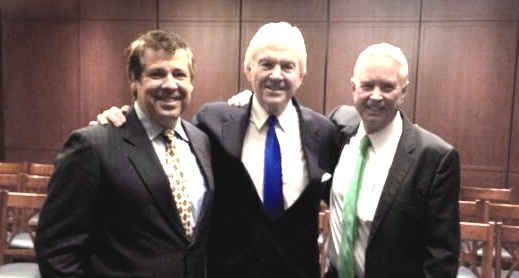
From the left: Steve Moore, John Douglas, and Michael Heavey.
In a room for hire at the Congress they made presentations of their misleading takes on the case to a near-empty room.
Senator Cantwell was apparently there briefly but took off as soon as she could. No other elected leaders were seen to be there.
There was seemingly no media coverage except for a sole post by another Knox apologist on the Infamous Ground Report.
These are hardly the most impartial or for that matter truthful and accurate observers of the case.
Click through for our numerous takedowns of the hapless Steve Moore, and John Douglas, and Michael Heavey.

